The Music Tiger:
Although Dr. Valerio Manfredi's take on Alexander did not make it in the race to produce an epic film about him, he is apparently busy collaborating with Dino De Laurentis and a couple of other historical projects:
"De Laurentis took an option on The Last Legion, Manfredi's novel which merges the last days of the Roman empire with Arthurian legend. Production should start next year, with Anthony Hopkins being talked of as a likely star. If anything, however, Manfredi is more enthusiastic about his own screenplay of another historical novelist's work, the widely acclaimed Memoirs of Hadrian, by Marguerite Yourcenar. It is going ahead, he explains, with Antonio Banderas as Hadrian and John Boorman directing.
Responding to occasional criticism from peers over his film involvement, Manfredi has observed in the past that 'a minority read books, while millions go to the cinema. You have to simplify, condense.' Mention Ernest Hemingway's famous comment about writing for the studios - 'You throw them your book, they throw you the money. Then you jump into your car and drive like hell back the way you came' - and he laughs. He would certainly have reservations about giving his work to certain directors, he says, although he regards his Memoirs of Hadrian screenplay as (relatively) safe in Boorman's hands - 'unless he has to make cuts ... But we have control of the screenplay.'"
Subsection of Roman Times:
A weblog of links to and abstracts from academic presentations on the Roman Empire
Monday, December 27, 2004
Wednesday, December 15, 2004
Roman influence in Chersonesos
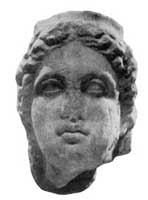 Chersonesos
Chersonesos
I noticed that this month's History Today featured an article about the ancient city of Chersonesos near Sebastopol in the Ukraine. It was referred to as the Ukrainian Pompeii so I was naturally interested in learning more. I found the official site of the National Preserve of Tauric Chersonesos and it included an extensive history of the city and its interaction with the Roman Empire.
"After Rome subdued the kingdom of Mithradates VI Eupator, Chersonesos found itself subordinate to Bosporos and remained so until Julius Caesar granted the city its eleutheria (freedom). A Chersonesan decree in honor of Gaius Julius Satirus, an ambassador to Julius Caesar, indicates that Chersonesos received its independence in 46-45 BC. After Caesar's death the Bosporan king Asandros attempted to subordinate Chersonesos once again, but the city successfully retained its independence. Around 25-24 BC Augustus normalized relations between the Chersonesan civil community and the Bosporan dynasts. Under the initiative of the Roman administration, Bosporos and Chersonesos created a defensive union which existed until war broke out between Rome and Bosporos. Chersonesos joined the side of Rome during the war, after which Chersonesos was granted certain privileges. The Roman administration became responsible for defending the city from the barbarian tribes. In the mid-60s AD the legate of the Roman province of Moesia, Tiberius Plautius Silvanus, aided Chersonesos in defeating the barbarians who were threatening the city. After these events the Roman authorities started to intervene in the internal politics of Chersonesos more forcefully, a circumstance which was reflected in the issue of coinage. Evidence which attests to the city's growing dependence on Rome during the Flavian dynasty includes the appearance in Chersonesos of statues of the Roman governors of Moesia, and the custom of granting the Chersonesan aristocracy Roman citizenship, a practice reserved for those regions outside the Roman empire which would soon become Roman provinces."
Friday, December 10, 2004
Australian Celtic Festival to Feature Roman War Machine
Gleninnes.yourguide: "Spectacular, colourful, new...that's what sums up the revamped Australian Celtic Festival, according to festival committee chairman Howard Eastwood.
The festival committee has big plans for the April festival, some which include explosive new attractions such as the firing of a replica Roman war machine similar to one used in the long and bloody campaigns during the Roman Empire's reign.
'The festival is now very much a national event and bridging on the international, attracting people from as far as Scotland,' festival committee chairman Howard Eastwood says. 'It's the opportunity for Australians to come together to pay homage to their Celtic heritage or simply to enjoy all things Celtic.'
There are plans to test fire the war machine at sunset on Thursday, April 28, from the Australian Standing Stones. The machine would shoot a spear with a flaming head from the Stones to the safety of open space."
The festival committee has big plans for the April festival, some which include explosive new attractions such as the firing of a replica Roman war machine similar to one used in the long and bloody campaigns during the Roman Empire's reign.
'The festival is now very much a national event and bridging on the international, attracting people from as far as Scotland,' festival committee chairman Howard Eastwood says. 'It's the opportunity for Australians to come together to pay homage to their Celtic heritage or simply to enjoy all things Celtic.'
There are plans to test fire the war machine at sunset on Thursday, April 28, from the Australian Standing Stones. The machine would shoot a spear with a flaming head from the Stones to the safety of open space."
Thursday, December 09, 2004
New BrainPOP Movies Teach Kids About Ancient Rome
'When in Rome...' New BrainPOP Movies Teach Kids About Ancient Rome: "BrainPOP (http://www.BrainPOP.com), the leading destination for educational Math, Science, and English animated content for kids, has added four new movies to its growing Social Studies library. BrainPOP's ROMAN REPUBLIC, RISE OF THE ROMAN EMPIRE, PAX ROMANA, and FALL OF THE ROMAN EMPIRE movies will give students a solid overview of the history of Ancient Rome. With Rome as their backdrop, Tim and his robot pal Moby lead kids through Rome's Republican beginnings, through the rise of Augustus Caesar and the cultural flowering of the Pax Romana, to Rome's destruction by barbarians. From rise to fall, BrainPOP's movies offer a perfect introduction to Rome for use at school or in the home. Each movie is accompanied by a 10-question interactive quiz, crossword puzzle, timeline, comic strip, and its very own fact sheet or experiment. BrainPOP's new ROME movies are part of the company's expansion of its award-winning content library to include topics in ancient and world history. BrainPOP subscribers will be able to access the new ROME movies in the Social Studies section along with recently added topics including titles like SUMERIANS, GREEK GODS, and ATHENS."
Did Roman Baths prompt the development of ancient plastic surgery?
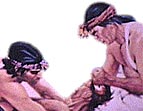 Ancient Roman Medicine:
Ancient Roman Medicine:
This past week I watched a special on the Discovery Channel about ancient plastic surgery. I had seen a program earlier about how surgeons in ancient India developed nose repair techniques that are still in use today. This information was included in the new program but was augmented by an interesting discussion of Roman plastic surgery. The narrator said that the most important influence on the development of plastic surgery in ancient Rome was the social emphasis on bathing in public baths. To avoid scandalous remarks, many men with battle scars on their backs, or worse, scars from flogging, sought a remedy from Roman surgeons. This was especially true of former slaves who sought to have brands or whip marks removed. I was surprised to learn that one of the most commonly requested procedures was circumcision reversal. Another procedure described was male breast reduction.
Since the Discovery Channel gets a little over zealous in its documentaries at times, I was a little dubious. But, I found this article with references that presented consistent information:
"It was war injuries, of course, that really advanced Roman surgery. If you were lucky, your military unit would have a good medicus/chirurgus who could patch you up before you bled to death, and if you were really lucky he might retire to the same colonia that you were pensioned off to. (Chirurgus was really a corruption of the Greek word for surgeon, which transliterates into English as 'cheirourgos'. The pure Latin phrase for surgeon was actually 'medicus vulnerarius', which means, literally, 'wound doctor'.) Roman military surgeons were, in fact, only rivaled by specialist arena surgeons, who repaired valuable gladiators.
Roman surgeons were also adept at several forms of minor plastic surgery. They did facial and other repairs, removed growths, etc. The most common operation appears to have been male de-circumcision. Reversal of genital mutilation, which might have been the result of religious observance or mischance, was an important procedure which one would seek in order to avoid embarrassment when appearing naked at the baths or in the gymnasia."
The program also mentioned that the Emperor Elagabalus asked a Roman surgeon to perform a sex change operation on him. However, it said there was no further evidence that such a procedure was, in fact, done. The narrator mentioned coyly that when Elagabalus was assassinated, it may have been the first assassination of of a Roman Empress!
Friday, November 19, 2004
New exhibit displays Greek and Roman statues ablaze with color
News: "An exhibition that opened this week at the Vatican Museums shows the fruit of years of research by the Vatican and two other top European museums, proving that the ancient Greeks and Romans lived not in a world of cold white marble gods and goddesses but amid a blazing riot of colours.
The statues as they have been seen for centuries are displayed alongside their replicas painted as the scholars now believe they were originally presented. The famous statue of Emperor Augustus, for example, discovered in Rome's Villa di Livia, now wears a scarlet toga, a variegated red and blue tunic, and armour decorated with multi-coloured images of gods; eyes, hair and lips are also painted.
Paolo Liverani of the Vatican Museums told Il Messaggero newspaper, 'Thanks to the most modern technologies, including ultraviolet photography, microscopic examination and clinical analysis, it has been possible to recover, in the originals of these sculptures, abundant traces of colour.'"
The statues as they have been seen for centuries are displayed alongside their replicas painted as the scholars now believe they were originally presented. The famous statue of Emperor Augustus, for example, discovered in Rome's Villa di Livia, now wears a scarlet toga, a variegated red and blue tunic, and armour decorated with multi-coloured images of gods; eyes, hair and lips are also painted.
Paolo Liverani of the Vatican Museums told Il Messaggero newspaper, 'Thanks to the most modern technologies, including ultraviolet photography, microscopic examination and clinical analysis, it has been possible to recover, in the originals of these sculptures, abundant traces of colour.'"
Thursday, November 18, 2004
PERCEPTIONS OF CLASSICAL ARMENIA: ROMANO-PARTHIAN RELATIONS, 70 BC-220 AD
 Masters Thesis by J Joseph Poirot III, Louisianna State University
Masters Thesis by J Joseph Poirot III, Louisianna State University
According to many modern scholars and several of the classical authors, Romans feared the looming threat of the Parthian state. Although such panic was unfounded, this fear
supposedly then prompted the Empire?s prolonged obsession with the territory of
Armenia, which both the scholarly and primary sources look upon as a military buffer
state. Yet in reality, Roman action in the East was not the result of a collective decision of all Roman citizens, but rather brought about by the individual wants and desires of Rome?s leaders. These leaders regarded Armenia not as a buffer state, but as a staging ground for their various campaigns against Parthia. It was their personal
ambitions, rather than Rome?s collective fear, that drew Armenia under the veil of
Roman hegemony. This project intends to examine Armenia?s role in the Romano-
Parthian conflict and hopes to prove that Roman imperialism was not defensive, as
some scholars assert, but rather the end product of the ambitions of individual Roman
leaders.
Thursday, November 04, 2004
Rome and the Barbarians
 I am listening to a lecture series on Rome and the Barbarians and Professor Harl has spent three lectures discussing the Roman conquest of Spain. I was not familiar with these activities and found it fascinating. Professor Harl said the Celt-Iberians were skilled warriors that were recruited by both the Romans and Carthaginians to fight in the Punic War. He pointed out, however, that after Carthage was defeated, the Celt-Iberians were not kept in the regular Roman Army for service elsewhere so they continued to raid the former Punic towns as a way of supporting themselves. He mentioned that they also suffered pressure from overpopulation in an area that could not readily support large numbers. The end result was that the Romans had to turn around and fight these former allies to protect the towns that were now under their control.
I am listening to a lecture series on Rome and the Barbarians and Professor Harl has spent three lectures discussing the Roman conquest of Spain. I was not familiar with these activities and found it fascinating. Professor Harl said the Celt-Iberians were skilled warriors that were recruited by both the Romans and Carthaginians to fight in the Punic War. He pointed out, however, that after Carthage was defeated, the Celt-Iberians were not kept in the regular Roman Army for service elsewhere so they continued to raid the former Punic towns as a way of supporting themselves. He mentioned that they also suffered pressure from overpopulation in an area that could not readily support large numbers. The end result was that the Romans had to turn around and fight these former allies to protect the towns that were now under their control.
Professor Harl said these wars in the mid-2nd century B.C.E. were particularly brutal, with casualties in the 40% range, because the Celt-Iberians were not only skilled but had been trained in sophisticated Roman and Carthaginian tactics. He said eventually Rome committed over 100,000 men to the control of Spain, primarily because of its mineral wealth. He also mentioned that Spain became the target of many ambitious Roman commanders for "triumph hunting". He cited cases where subsequent governors would intentionally start wars by breaking existing treaties just to try to wangle a triumph out of the senate.
I also thought it was interesting that during the Republican period, Sertorius used mythology to help control these Spanish peoples by having a pet fawn appear at propitious times engendering the belief that he was favored by the goddess Diana.
Friday, October 08, 2004
Comic book artist recreates ancient Rome
Seattle Post-Intelligencer: "Imagine ancient Rome before its fall: The some 1,350 fountains still trickle with water, the 1,790 palaces haven't fallen to ruins and the 240 public latrines are still in business.
In painstaking detail, French comic book artist Gilles Chaillet has brought the ancient city back to life with an immense map based on a lifetime of research and a touch of artistic license.
Chaillet's immense map is colored in with cheerful greens, russets and pearly tones by his wife, Chantal. Looking at it, you can imagine a day's stroll in Rome circa 314 A.D.: a leisurely morning at the bathhouses, a stop at the market to buy some chickpeas and trip to the Circus Maximus to take in a chariot race.
He set his map in 314 A.D. because the majestic and well-preserved Arch of Constantine wasn't built until around then, and he felt most Rome-lovers couldn't imagine the city without it.
At that time, Rome had about 1 million inhabitants and was ruled by Constantine I, who legalized Christianity.
When Chaillet finally sat down to sketch the 11 foot-by-6.5 foot map, he spent 5,000 hours at the drawing board. His wife spent another 3,000 hours coloring it in.
Chaillet thinks that about 5 percent of the map's 13,000 buildings are completely accurate. About 30 percent are fairly accurate, and the rest is based on educated guesses, he said."
In painstaking detail, French comic book artist Gilles Chaillet has brought the ancient city back to life with an immense map based on a lifetime of research and a touch of artistic license.
Chaillet's immense map is colored in with cheerful greens, russets and pearly tones by his wife, Chantal. Looking at it, you can imagine a day's stroll in Rome circa 314 A.D.: a leisurely morning at the bathhouses, a stop at the market to buy some chickpeas and trip to the Circus Maximus to take in a chariot race.
He set his map in 314 A.D. because the majestic and well-preserved Arch of Constantine wasn't built until around then, and he felt most Rome-lovers couldn't imagine the city without it.
At that time, Rome had about 1 million inhabitants and was ruled by Constantine I, who legalized Christianity.
When Chaillet finally sat down to sketch the 11 foot-by-6.5 foot map, he spent 5,000 hours at the drawing board. His wife spent another 3,000 hours coloring it in.
Chaillet thinks that about 5 percent of the map's 13,000 buildings are completely accurate. About 30 percent are fairly accurate, and the rest is based on educated guesses, he said."
Tuesday, October 05, 2004
Hannibal ad portas - The Power and Wealth of Carthage
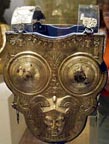 "It was said that Hannibal took an oath from his father when he was 9, that he would hate Rome for life. Also Carthage?s Queen Dido was quoted as saying: "Neither love nor treaty shall there be between the nations... Let your shores oppose their shores, your waves their waves, your arms their arms. This is my prayer let them fight, they and their sons', forever."
"It was said that Hannibal took an oath from his father when he was 9, that he would hate Rome for life. Also Carthage?s Queen Dido was quoted as saying: "Neither love nor treaty shall there be between the nations... Let your shores oppose their shores, your waves their waves, your arms their arms. This is my prayer let them fight, they and their sons', forever."
Following Hannibal's trail, selected items from a total of 450 exhibits can be touched and explored at a new exhibit running through January 30, 2005 at the state museum in Karlsruhe, Germany.
Tuesday, September 14, 2004
Rome vs. Carthage: The Day the World Trembled
 Rome vs. Carthage: The Day the World Trembled:
Rome vs. Carthage: The Day the World Trembled:
I subscribe to Military History Magazine and recommend it heartily. This article appeared in a recent issue and it is a very nice overview of the Punic Wars:
"That the two greatest powers of the Mediterranean should come into mortal conflict was inevitable. Both were vigorous, aggressive, exceptionally organized and well-led. As each expanded its boundaries, ultimately there was no way that a clash of arms could be avoided. The titanic struggle between the two superpowers of the ancient world lasted more than 60 years before one side emerged the indisputable victor.
The showdown came over fair, fertile and rich Sicily, which stood in the path of Rome's expansion toward the south and that of Carthage toward the north. In 264 bc the two mighty empires collided, and for nearly a quarter century, they tore Sicily apart in inconclusive combat. Gradually, Rome gained the upper hand, but several years before the end of the struggle a military genius arose on the Punic side: Hamilcar, surnamed Barca -- "the thunderbolt." His brilliant tactics restored the military balance, and the war slowly ground down to an exhausted stalemate.
In the end, the outcome was decided at sea. The Romans initially had been no match for the Carthaginians in naval warfare, but with typical Roman ingenuity they overcame their deficiency by the invention of the corvu (crow), a long plank with a heavy spike protruding from the end that, when dropped, effectively pinned two warships together. This transformed a sea battle into a land battle, and Roman soldiers -- in essence the world's first marines -- could rush over the plank and fight the enemy hand to hand. The First Punic War came to an end at the naval battle of Aegusa in 241 bc. The Roman navy won a decisive victory over the Carthaginians, and the remaining Punic strongholds on Sicily could now be blockaded."
Performing Cicero
 This is an interesting website where you can view three different reenactments of Cicero's famous defense of Marcus Caelius. I particularly enjoyed version 1 since the New Zealand actor seemed to resemble Cicero more and was more flamboyant. Based on reading the actual speech in the internet archives and remembering its portrayal in one of my favorite books by Steven Saylor, "The Venus Throw", I couldn't help but enjoy the New Zealand version more.
This is an interesting website where you can view three different reenactments of Cicero's famous defense of Marcus Caelius. I particularly enjoyed version 1 since the New Zealand actor seemed to resemble Cicero more and was more flamboyant. Based on reading the actual speech in the internet archives and remembering its portrayal in one of my favorite books by Steven Saylor, "The Venus Throw", I couldn't help but enjoy the New Zealand version more.
"Impersonation, known by the general terms fictio personae in Latin and prosopopoeia in Greek, was a way to vary and animate a speech by summoning a figure to speak the orator's sentiments in his (or her or its) own voice (cf. Quint. Inst. 9.2.29-35). The device brought the orator's style of performance ever closer to the actor's and encouraged a certain grandeur of manner and style. Among the most famous prosopopoeiae in Roman oratory is a passage from Cicero's speech in defense of Marcus Caelius where the advocate, having already cast Caelius' jilted lover Clodia as the evil genius behind the prosecution, summons her distinguished ancestor Appius Claudius Caecus to shame and scold her for her conduct."
Servius Sulpicius Topic of Roman Law Lecture
 In a recent lecture, Cornell University Professor Okko Behrends "explored Servius Sulpicius's powerful influence on Roman law, and discussed the overshadowing of the great orator by his better-known counterpart Cicero. Behrends outlined the two law schools of their era: the humanistic law of Servius and the pre-classical natural law, illuminating how Servius's ideas represented a major break from the latter's imposing influence on legal thought.
In a recent lecture, Cornell University Professor Okko Behrends "explored Servius Sulpicius's powerful influence on Roman law, and discussed the overshadowing of the great orator by his better-known counterpart Cicero. Behrends outlined the two law schools of their era: the humanistic law of Servius and the pre-classical natural law, illuminating how Servius's ideas represented a major break from the latter's imposing influence on legal thought.
Servius, Behrends said, believed that law was manmade. He understood that 'the rules are laid down by human understanding ... not part of natural reason which only needs detection.' Behrends likened this debate to the phenomenon of language: is language given to mankind, or does man create it himself?
'He no longer accepted floating legal principles; law, Servius believed, should be definite. Law is realized in civil equity or distinct moral qualities inherent in man's consciousness,' Behrends said."
Thursday, August 19, 2004
Ancient India and Rome new exhibition in New Delhi
The Hindu : Treading the old Roman trade route: "The Italian Cultural Centre in New Delhi is celebrating an ancient connection with India by putting together an exhibition with some history behind it.
Bringing to light the intense trade relations between the Roman Empire and India, the exhibition titled 'Ancient India and Rome' hopes to give viewers a chance to catch a glimpse of the past. And for those who could see a `desi' link in the 'Gladiator'', this exhibition provides proof of the Indian connection.
The exhibition aims to throw light on the importance of such exchanges that developed in a particular way during the Roman era when the Pax Augusta enabled the broadening of the markets because of the ever insatiable appetite of the rich Roman middle-classes for spices and luxury products.
The exhibition highlights the "treasures" of the time -- "Amphorae", vases, commonly used bronze objects, Mediterranean terracotta statuettes and Roman coins found in abundance in India.
With their influence extending beyond just commerce, the Romans found a mention in Indian literary texts. While texts speak about the colonies of "Yavanas'' (Westerners) along the coast, archaeological discoveries and literary references substantiate the claims."
Bringing to light the intense trade relations between the Roman Empire and India, the exhibition titled 'Ancient India and Rome' hopes to give viewers a chance to catch a glimpse of the past. And for those who could see a `desi' link in the 'Gladiator'', this exhibition provides proof of the Indian connection.
The exhibition aims to throw light on the importance of such exchanges that developed in a particular way during the Roman era when the Pax Augusta enabled the broadening of the markets because of the ever insatiable appetite of the rich Roman middle-classes for spices and luxury products.
The exhibition highlights the "treasures" of the time -- "Amphorae", vases, commonly used bronze objects, Mediterranean terracotta statuettes and Roman coins found in abundance in India.
With their influence extending beyond just commerce, the Romans found a mention in Indian literary texts. While texts speak about the colonies of "Yavanas'' (Westerners) along the coast, archaeological discoveries and literary references substantiate the claims."
Tuesday, August 17, 2004
Croatian memorial stone source of latest Arthur incarnation
 "CROATIA is a strange place to discover a clue linking King Arthur with Cumbria. But John Matthews, who was a historical advisor on the newly released Hollywood film King Arthur, says the memorial stone of an Anglo-Roman commander found in a Croatian village adds weight to the theory that places the legend against the backdrop of Hadrian's Wall.
"CROATIA is a strange place to discover a clue linking King Arthur with Cumbria. But John Matthews, who was a historical advisor on the newly released Hollywood film King Arthur, says the memorial stone of an Anglo-Roman commander found in a Croatian village adds weight to the theory that places the legend against the backdrop of Hadrian's Wall.
Mr Matthews, a leading expert on the legend, from Oxfordshire, says: The historical theory is that a Romano-British leader, Lucius Artorius Castus, was stationed at Hadrian's Wall, probably at Birdoswald.
We know he was the commander of a legion of Sarmatian warriors, who came from between the Black Sea and the Caspian Sea in the second century AD towards the end of Roman rule in Britain. A Roman habit of including a potted biography on a memorial tells historians where Lucius Artorius Castus was stationed and that he was commanding some of the 5,500 Sarmatians, skilled cavalrymen, brought to Britain to fight.
Archeological finds show Sarmatians stayed in Britain long after the Romans left, remaining in a tight knit ethnic group and, like Arthur, their battle insignia was a dragon.
Also, as in the Excalibur myth, they worshipped an image of a sword stuck in the ground as the symbol of their god of war."
Actors take a hike for new play about Hadrian's Wall
: "Actors rehearsing a new play about Hadrian's Wall are learning their lines, blocking their moves, doing route marches and soaking their feet in surgical spirit in preparation for its world premiere in a Cumbrian village hall on Thursday.
The day after each show in communities along the wall, the six actors plus the playwright will don boots and waterproofs and give another kind of blistering performance, striding 10 miles to the next venue.
They will step out along 84 miles of the Hadrian's Wall path, a national trail opened last year."
The day after each show in communities along the wall, the six actors plus the playwright will don boots and waterproofs and give another kind of blistering performance, striding 10 miles to the next venue.
They will step out along 84 miles of the Hadrian's Wall path, a national trail opened last year."
Wednesday, August 11, 2004
Leo III's Ecloga Revises legal penaties in the late Roman Empire
LATER ROMAN EMPIRE: "In a synod held at Constantinople in the reign of Justinian II. numerous rules were enacted, differing from the existing laws and based on ecclesiastical doctrine and Mosaic principles, and these were sanctioned as laws of the realm by the emperor. Thus Church influence and the decline of Roman tradition, in a state which had become predominantly Greek, determined the character of the ensuing legislative epoch under the auspices of Leo III., whose law book (A.D. 740), written in Greek, marks a new era and reflects the changed ideas of the community. Entitled a Brief Selection of Laws and generally known as the Ecloga, it may be described as a Christian law book. In regard to the patria potestas increased facilities are given for emancipation from paternal control when the son comes to years of discretion, and the paternal is to a certain extent replaced by a pareiital control over minors. The, law of guardianship is considerably modified. The laws of marriage are transformed under the influence of the Christian conception of matrimony; the institution of concubinatus is abolished. Impediments to marriage on account of consanguinity and of spiritual relationship are multiplied. While Justinian regarded marriage as a contract, and therefore, like any other contract, dissoluble at the pleasure of the parties, Leo III. accepted the Church view that it was an indissoluble bond. Ecclesiastical influence is written large in the criminal law, of which a prominent feature is the substitution of mutilation of various kinds for the capital penalty. Death is retained for some crimes, such as murder and high treason; other offences were punished by amputation (of hand, nose, &c.). This system (justified by the passage in the New Testament, If thine eye offend thee, &c.), though to modern notions barbaric, seemed a step in the direction of leniency; and it may be observed that the tendency to avoid capital punishment increased, and we are told that in the reign of John Comnenus it was never inflicted. (The same spirit, it may be noted, is apparent in the usual, though by no means invariable, practice of Byzantine emperors to render dethroned rivals or members of a deposed dynasty innocuous by depriving them of eyesight or forcing them to take monastic orders, instead of putting them to death.) The Church, which had its own system of penalties, exercised a great influence on the actual operation of criminal law, especially through the privilege of asylum (recognized by justinian, but with many reserves and restrictions), which was granted to Christian churches and is admitted without exceptions in the Ecloga."
I wonder what reservations and restrictions Justinian had legislated?
I wonder what reservations and restrictions Justinian had legislated?
Romans and Taxes
Warsaw Business Journal Online - business in poland,warsaw,polish companies,companies database: "The first recorded evidence of tax dates back to 2350 B.C. Tomb paintings in Egypt depict relentless tax collectors selling delinquents into slavery for failure to pay tax on fish catches and garden produce. The Greeks fought a bloody war against Persia to resist a tribute tax, but then had to impose one to pay for the war.
Ancient Rome had an elaborate tax system which encompassed sales taxes, inheritance taxes and taxes on imports and exports. In the 4th century BC, the Romans built a tax-free shipping port at Delos, which some refer to as history's first tax haven. It was also the Romans who first invented inheritance tax, imposed upon all citizens at the rate of 10 percent, and who introduced imprisonment for tax evasion. "
The last statement surprised me because I was under the impression the Romans had no prison system, at least not in Rome itself.
Ancient Rome had an elaborate tax system which encompassed sales taxes, inheritance taxes and taxes on imports and exports. In the 4th century BC, the Romans built a tax-free shipping port at Delos, which some refer to as history's first tax haven. It was also the Romans who first invented inheritance tax, imposed upon all citizens at the rate of 10 percent, and who introduced imprisonment for tax evasion. "
The last statement surprised me because I was under the impression the Romans had no prison system, at least not in Rome itself.
Wednesday, July 28, 2004
Healthcare in the Roman Empire
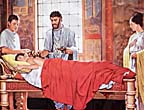 I was rewatching a fascinating program on Galen the other night on the History Channel that included a model of a Roman hospital or Valetudinarium. It used the inner courtyard flooded with sunlight for the operating theater. It had consulting rooms, a kitchen for food preparation, an area where instruments were sterilized in forge-like structures all surprisingly similar to a modern health care facility.
I was rewatching a fascinating program on Galen the other night on the History Channel that included a model of a Roman hospital or Valetudinarium. It used the inner courtyard flooded with sunlight for the operating theater. It had consulting rooms, a kitchen for food preparation, an area where instruments were sterilized in forge-like structures all surprisingly similar to a modern health care facility.
I found a detailed description of the valetudinarium at the archaeological site of Novae.
In addition I found a site about Byzantine medicine.
I also found this interesting quiz about Roman health care:
http://www.educationforum.co.uk/rome.htm
Monday, July 26, 2004
Hellenic Influence On Modern Law Codes
Hellenic Influence On Modern Law Codes"Many contemporary legal scholars claim that the American legal system has its roots in Rome, and more specifically, the legal codes of Gaius and Justinian. Others trumpet the English system of common law, and contend that it is the rightful forefather of our current legal system. These views are not completely merit-less of course. But to the extent that they seek to disclaim the role played by ancient Greece in creating today's modern legal institutions, they do a grave injustice to our collective understanding of law and its origins."
"Our comparison begins with an examination of the overall structure of the two legal systems. Using 4th century BC Athens as a point of reference, one sees that the ancient Greeks devised their court system to handle two basic types of cases: the private case (dike), and the public case (graphe). The dike was used to resolve private, individual disputes between litigants (e.g., failure to pay for goods received), while the graphe was used to resolve disputes that impacted the community as a whole (e.g., treason). Most courts in the United States possess a similar structure: a private citizen claiming some type of personal harm can bring an action as a plaintiff in a "civil suit," while government prosecutors, acting on behalf of the entire community, can bring criminal suits against individuals not for compensation, but to effect community-based penological goals such as retribution and deterrence."
"In ancient Greece, both dikai and graphai were initiated by filing a written complaint and "summoning" the defendant to the magistrate."
"Moreover, both cultures implemented a jury system to make determinations of guilt and innocence...although juries in ancient Greece were generally larger than the ones we empanel today - for instance, a jury in Athens could consist of several hundred, and in certain rare instances, several thousand members - the critical point is that, in both societies, the most consequential decisions were left to a jury of the accused's peers."
"One commonly voiced criticism of the ancient Greek legal system is that, unlike the legal systems of ancient Rome and modern America, it operated without the benefit of lawyers. This criticism is misplaced, however, because ample guidance was available to ancient Greek litigants in the form of the logographos. The logographos was, in essence, a speechwriter who usually had considerable experience either litigating or observing trials. As such, skilled logographoi such as Demosthenes and Isocrates were in high demand, just as skilled American lawyers like Plato Cacheris are here today."
"Other similarities abound between the two legal cultures. For instance, a concern about frivolous lawsuits, and a procedural device to discourage them, is a hallmark of both ancient Greece and modern America. Procedures for alternative dispute resolution" are another characteristic of both legal regimes. Statutes of limitation, which serve to define the time frame within which a claim must be commenced, are an integral part of American legal system, and there is widespread scholarly agreement that these laws find their origins in the real property laws of ancient Greece.
"Our comparison begins with an examination of the overall structure of the two legal systems. Using 4th century BC Athens as a point of reference, one sees that the ancient Greeks devised their court system to handle two basic types of cases: the private case (dike), and the public case (graphe). The dike was used to resolve private, individual disputes between litigants (e.g., failure to pay for goods received), while the graphe was used to resolve disputes that impacted the community as a whole (e.g., treason). Most courts in the United States possess a similar structure: a private citizen claiming some type of personal harm can bring an action as a plaintiff in a "civil suit," while government prosecutors, acting on behalf of the entire community, can bring criminal suits against individuals not for compensation, but to effect community-based penological goals such as retribution and deterrence."
"In ancient Greece, both dikai and graphai were initiated by filing a written complaint and "summoning" the defendant to the magistrate."
"Moreover, both cultures implemented a jury system to make determinations of guilt and innocence...although juries in ancient Greece were generally larger than the ones we empanel today - for instance, a jury in Athens could consist of several hundred, and in certain rare instances, several thousand members - the critical point is that, in both societies, the most consequential decisions were left to a jury of the accused's peers."
"One commonly voiced criticism of the ancient Greek legal system is that, unlike the legal systems of ancient Rome and modern America, it operated without the benefit of lawyers. This criticism is misplaced, however, because ample guidance was available to ancient Greek litigants in the form of the logographos. The logographos was, in essence, a speechwriter who usually had considerable experience either litigating or observing trials. As such, skilled logographoi such as Demosthenes and Isocrates were in high demand, just as skilled American lawyers like Plato Cacheris are here today."
"Other similarities abound between the two legal cultures. For instance, a concern about frivolous lawsuits, and a procedural device to discourage them, is a hallmark of both ancient Greece and modern America. Procedures for alternative dispute resolution" are another characteristic of both legal regimes. Statutes of limitation, which serve to define the time frame within which a claim must be commenced, are an integral part of American legal system, and there is widespread scholarly agreement that these laws find their origins in the real property laws of ancient Greece.
The Iron Lady Returns
The Iron Lady Is ReturningThe Iron Lady Is Returning SUPERWOMAN with a chariot, Essex girl with attitude, Celtic madonna with a spear, Maggie Thatcher with dreads, Braveheart with a bra: these are just some of the images that have been dug up to explain why Hollywood has suddenly gone ape about Boudicca or Boadicea...Add the fact that her rebellion was partly her response to the rape of her daughters by Romans or the theory that she was a "proto-feminist lesbian sexpot" and Boudicca is a writer's dream.
As long ago as 1984, in her book Another Mother Tongue, the poet Judy Grahn made the astounding claim that "bulldyke" is a corruption of the war queen's name and that it would have been "unnatural" if she had not been a lesbian. Theories like that have been given oxygen because so little is known about Boudicca's life and it helps that the facts have been lovingly intertwined with legends."
It always irritates me that strong women with leadership capabilities are frequently portrayed as non-traditional in some way. Why does a society dominated by men feel threatened enough by talented women that they must always be treated as an anomaly?
This article goes on to say:
"Four films are in the offing, one of which is being produced by Mel Gibson, fresh from his bloody recreation of the torment and execution of Jesus Christ.
In addition to Gibson's movie Warrior, Dreamworks is making Queen Fury, Paramount's effort is Warrior Queen, not to be confused with last year's ITV production starring Alex Kingston and another project is called My Country.
Boudicca was a real person who waged a real guerrilla war, but she has also been transformed utterly by the legend of the inspirational warrior queen. The trick will be to portray her as a field commander capable of duffing up the Romans and blessed with enough sex appeal to get the men behind her. Think Nicole Kidman with spears."
Nicole Kidman??? Give me a break. They tried to make her out to be a nuclear scientist in "The Peacemakers" and she couldn't lend enough weight to that role either. Also, despite the studio hype, I simply do not find her to be that talented. Now, take Renee Zellweger and you have a whole new ball game. She could definitely give the role all the punch and emotional tension it would require. Olivia Williams would be another good possibility. Her scenes in "The Postman" where she is shooting at General Bethlehem certainly convinced me she meant business! I also thought Sophie Marceau portrayed a strong female character in "Braveheart" as did Connie Nielsen in "Gladiator". Any of these women would make a far better choice than Kidman.
As long ago as 1984, in her book Another Mother Tongue, the poet Judy Grahn made the astounding claim that "bulldyke" is a corruption of the war queen's name and that it would have been "unnatural" if she had not been a lesbian. Theories like that have been given oxygen because so little is known about Boudicca's life and it helps that the facts have been lovingly intertwined with legends."
It always irritates me that strong women with leadership capabilities are frequently portrayed as non-traditional in some way. Why does a society dominated by men feel threatened enough by talented women that they must always be treated as an anomaly?
This article goes on to say:
"Four films are in the offing, one of which is being produced by Mel Gibson, fresh from his bloody recreation of the torment and execution of Jesus Christ.
In addition to Gibson's movie Warrior, Dreamworks is making Queen Fury, Paramount's effort is Warrior Queen, not to be confused with last year's ITV production starring Alex Kingston and another project is called My Country.
Boudicca was a real person who waged a real guerrilla war, but she has also been transformed utterly by the legend of the inspirational warrior queen. The trick will be to portray her as a field commander capable of duffing up the Romans and blessed with enough sex appeal to get the men behind her. Think Nicole Kidman with spears."
Nicole Kidman??? Give me a break. They tried to make her out to be a nuclear scientist in "The Peacemakers" and she couldn't lend enough weight to that role either. Also, despite the studio hype, I simply do not find her to be that talented. Now, take Renee Zellweger and you have a whole new ball game. She could definitely give the role all the punch and emotional tension it would require. Olivia Williams would be another good possibility. Her scenes in "The Postman" where she is shooting at General Bethlehem certainly convinced me she meant business! I also thought Sophie Marceau portrayed a strong female character in "Braveheart" as did Connie Nielsen in "Gladiator". Any of these women would make a far better choice than Kidman.
Thursday, July 22, 2004
Dogs in Ancient Greece and Rome
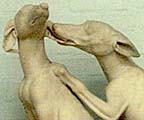 This is a very interesting article about the different types of dogs used in ancient Greece and Rome. It even mentions that hounds were imported from Britain before the conquest: "Hounds from Celtic Britain were famous, as well, and exported to Rome even before the conquest. (Writing at the beginning of the first century BC, the Greek geographer Strabo mentions dogs 'that are by nature suited to the purposes of the chase.') 'It is not only Spartan whelps or only Molossian which you must rear,' says the poet Nemesianus in Cynegetica (c.AD 283), 'sundered Britain sends us a swift sort, adapted to hunting-tasks in our world.' Claudian also speaks of 'slender Spartans, and Britons that can break the backs of mighty bulls.' Such animals, which may have been Irish wolf hounds, can be seen chasing rabbits on the Celtic Castor ware beakers of Britain from the second century AD."
This is a very interesting article about the different types of dogs used in ancient Greece and Rome. It even mentions that hounds were imported from Britain before the conquest: "Hounds from Celtic Britain were famous, as well, and exported to Rome even before the conquest. (Writing at the beginning of the first century BC, the Greek geographer Strabo mentions dogs 'that are by nature suited to the purposes of the chase.') 'It is not only Spartan whelps or only Molossian which you must rear,' says the poet Nemesianus in Cynegetica (c.AD 283), 'sundered Britain sends us a swift sort, adapted to hunting-tasks in our world.' Claudian also speaks of 'slender Spartans, and Britons that can break the backs of mighty bulls.' Such animals, which may have been Irish wolf hounds, can be seen chasing rabbits on the Celtic Castor ware beakers of Britain from the second century AD."
Monday, July 19, 2004
Secrets of Ancient Battle Strategies Come to Life in DECISIVE BATTLES
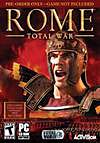 Secrets of Ancient Battle Strategies Come to Life in DECISIVE BATTLES: "It's hard to imagine that the tranquil fields of present day Italy, Greece and other Mediterranean lands were once the site of some of the most historic battles of ancient times. But now, The History Channel goes on location to the actual battlefields and integrates cutting-edge videogame technology to bring history and imagination together in the new series DECISIVE BATTLES.
Secrets of Ancient Battle Strategies Come to Life in DECISIVE BATTLES: "It's hard to imagine that the tranquil fields of present day Italy, Greece and other Mediterranean lands were once the site of some of the most historic battles of ancient times. But now, The History Channel goes on location to the actual battlefields and integrates cutting-edge videogame technology to bring history and imagination together in the new series DECISIVE BATTLES.
DECISIVE BATTLES is unlike any series The History Channel has ever aired. Employing the same advanced computer gaming technology as in the highly- anticipated new video game Rome: Total War(TM), the series gives viewers an unprecedented perspective of ancient battles by re-creating troops in their vast numbers and landscapes on a scale otherwise impossible."
The series will recreate Cannae, Gaugamela, Thermopylae, Marathon, the Spartacan Revolt, Chalons, Carrhae, Adrianople, Pharsalus, Cynoscephalae, Watling Street (Boudicca), Teutoburg Forest, and Kadesh.
Friday, July 16, 2004
Fossilized plague-ridden Egyptian insects challenge plague origin theories
 Fossilized plague in Egypt"In almost all cases, plague epidemics strike areas with poor and cramped living conditions, much like the "Workmen's Village" section of Amarna where Eva Panagiotakopulu, a paleoentomologist at Sheffield University in England, carried out her research on fossilized insect remains. Amarna, the site of excavations by Barry Kemp (a renowned Egyptologist from the University of Cambridge), is a good place to study ancient life in Egypt, Panagiotakopulu says, because the site is well-preserved in the dry desert sands. Archaeologists have flocked to the site for more than 100 years to learn why the city was capital for only 20 years (around 1350 to 1330 B.C.) and then abandoned. However, Panagiotakopulu is the first to look at fossilized insect remains in the ancient city.
Fossilized plague in Egypt"In almost all cases, plague epidemics strike areas with poor and cramped living conditions, much like the "Workmen's Village" section of Amarna where Eva Panagiotakopulu, a paleoentomologist at Sheffield University in England, carried out her research on fossilized insect remains. Amarna, the site of excavations by Barry Kemp (a renowned Egyptologist from the University of Cambridge), is a good place to study ancient life in Egypt, Panagiotakopulu says, because the site is well-preserved in the dry desert sands. Archaeologists have flocked to the site for more than 100 years to learn why the city was capital for only 20 years (around 1350 to 1330 B.C.) and then abandoned. However, Panagiotakopulu is the first to look at fossilized insect remains in the ancient city.
The Workmen's Village was the section near the ancient capital reserved for the artisans who toiled on the nearby stone tombs for the pharaohs Akhenaten and Tutankhamun. There, Panagiotakopulu found a very high frequency of fossilized human fleas, bedbugs and other insects and parasites that "present a picture of squalid living conditions" in and around the workers' houses, she says.
Because pandemic plague throughout history often first showed itself by a large number of black rat deaths, scientists have long thought that plague originated in India and Central Asia, where black rats were endemic. They thought the plague then spread throughout the Mediterranean and Europe by fleas on black rats that entered the Mediterranean region via shipboard trading. But the identification of fossilized plague bacteria in the fossilized fleas in Egypt led Panagiotakopulu to hypothesize that plague instead originated in Africa, in fleas that fed on the endemic Nile rat. The plague only grew to epidemic proportions when the Asian black rats - new hosts - were introduced to Egypt, Panagiotakopulu wrote in the February Journal of Biogeography.
Thursday, July 15, 2004
Lays of Ancient Rome
By THOMAS B. MACAULAY
Lays of Ancient Rome: "There can be little doubt that among those parts of early Roman history which had a poetical origin was the legend of Horatius Codes. We have several versions of the story, and these versions differ from each other in points of no small importance. Polybius, there is reason to believe, heard the tale recited over the remains of some consul or praetor descended from the old Horatian patricians; for he introduces it as a specimen of the narratives with which the Romans were in the habit of embellishing their funeral oratory. It is remarkable that, according to him, Horatius defended the bridge alone, and perished in the waters. According to the chronicles which Livy and Dionysus followed, Horatius had two companions, swam safe to shore, and was loaded with honors and rewards.
It is by no means unlikely that there were two old Roman lays about the defense of the bridge; and that, while the story which Livy has transmitted to us was preferred by the multitude, the other, which ascribed the whole glory to Horatius alone, may have been the favorite with the Horatian house."
Lays of Ancient Rome: "There can be little doubt that among those parts of early Roman history which had a poetical origin was the legend of Horatius Codes. We have several versions of the story, and these versions differ from each other in points of no small importance. Polybius, there is reason to believe, heard the tale recited over the remains of some consul or praetor descended from the old Horatian patricians; for he introduces it as a specimen of the narratives with which the Romans were in the habit of embellishing their funeral oratory. It is remarkable that, according to him, Horatius defended the bridge alone, and perished in the waters. According to the chronicles which Livy and Dionysus followed, Horatius had two companions, swam safe to shore, and was loaded with honors and rewards.
It is by no means unlikely that there were two old Roman lays about the defense of the bridge; and that, while the story which Livy has transmitted to us was preferred by the multitude, the other, which ascribed the whole glory to Horatius alone, may have been the favorite with the Horatian house."
Tuesday, July 13, 2004
Jerash to Host Roman Army and Chariot Experience
 The Roman Army and Chariot Experience"Are you ready for war?" cries a Centurion and Roman legionaries’ roar of "Ready, ready, ready" echoes around the restored hippodrome in Jerash, Jordan.
The Roman Army and Chariot Experience"Are you ready for war?" cries a Centurion and Roman legionaries’ roar of "Ready, ready, ready" echoes around the restored hippodrome in Jerash, Jordan.
"Unseen until now, an enemy force appears without warning to your left, on the South Tower. The Romans bring their artillery, renowned for its accuracy and power, into action, delivering missiles at targets at the north end of the hippodrome and then engage the enemy with siege tower and battering ram.
After a vigorous battle the South Tower is captured and the victorious commander rides through the serried ranks of his troops in a triumphal chariot drawn by four horses, accompanied, as was the custom, by a slave who reminds him of his mortality
with the words, "Memento mori."
As the legionaries withdraw, racing chariots appear in a whirl of dust, one for each of the fiercely supported factions, the Reds, Blues, Greens and Whites. Having paraded before you, they take up their position in the carceres. The starter is announced by a fanfare of trumpets and as he drops a white scarf, they burst forward into the first of seven laps, jostling for position at the turn. Choose your favourite colour and give them the most vocal support - you might even be able to hear a faint echo coming down the years!"
This thrilling historical recreation will be presented for visitors to Jordan's ancient city of Jerash beginning in the Spring of 2005.
Friday, July 09, 2004
Ceramics from Roman Africa Exhibited
 : "THE KNIGHTS OF COLUMBUS MUSEUM in Thomaston, Connecticut is presenting a new exhibition featuring 105 pieces of African Red Slip Ware ceramics from the Third through the Sixth Centuries. The items are on loan from the Harvard University Art Museums and private collectors. These red clay ceramics--bowls, plates, jugs and lamps--were produced in provinces located in what is now modern Tunisia in North Africa and exported throughout the Roman Empire."
: "THE KNIGHTS OF COLUMBUS MUSEUM in Thomaston, Connecticut is presenting a new exhibition featuring 105 pieces of African Red Slip Ware ceramics from the Third through the Sixth Centuries. The items are on loan from the Harvard University Art Museums and private collectors. These red clay ceramics--bowls, plates, jugs and lamps--were produced in provinces located in what is now modern Tunisia in North Africa and exported throughout the Roman Empire."
See also: "Light from the Age of Augustine"
Restoration Advances Salvage Marcus Aurelius Statue
 Statue of an Emperor (Getty Exhibitions): "Composed of approximately 40 fragments of four different types of marble, some original, others carved during different restoration campaigns of the 18th and 19th centuries, the statue of Marcus Aurelius belonging to the Pergamon Museum in Berlin was in danger of collapsing because the joints between the fragments had loosened over time. Getty Museum conservators took the statue completely apart and reassembled it.
Statue of an Emperor (Getty Exhibitions): "Composed of approximately 40 fragments of four different types of marble, some original, others carved during different restoration campaigns of the 18th and 19th centuries, the statue of Marcus Aurelius belonging to the Pergamon Museum in Berlin was in danger of collapsing because the joints between the fragments had loosened over time. Getty Museum conservators took the statue completely apart and reassembled it.
The work is explored in video segments showing this process as it took place in the conservation laboratories of the Getty Museum. The exhibition, available until September 12, highlights changes in restoration and conservation practices that have occurred between the 18th and 21st centuries."
Getty Museum Examines Byzantine Empire
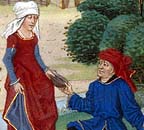 Art Museum Network News: "The widespread influence of the Byzantine Empire on neighboring countries and the enduring legacy of its art are explored in the new Getty exhibition 'Byzantium and the West,' at the Getty Center, September 14 - December 5, 2004. The exhibition features manuscripts that showcase the distinctive brilliance of Byzantine art and highlight the manner in which different cultures reacted to the artistic heritage of the Empire over time.
Art Museum Network News: "The widespread influence of the Byzantine Empire on neighboring countries and the enduring legacy of its art are explored in the new Getty exhibition 'Byzantium and the West,' at the Getty Center, September 14 - December 5, 2004. The exhibition features manuscripts that showcase the distinctive brilliance of Byzantine art and highlight the manner in which different cultures reacted to the artistic heritage of the Empire over time.
Drawn primarily from the Getty's rich collection, the works on view include bound manuscripts, leaves, and a painting, all dating from the 11th through 17th centuries. Among these are several loans from other West Coast collections. The exhibition explores the striking naturalism and courtly splendor that distinguishes Byzantine art, and examines the diverse ways in which the highly admired style was emulated by three of Byzantium's closest neighbors: Germany, Italy, and Armenia. "
Thursday, July 08, 2004
A Gritty Roman Arthur More Realistic
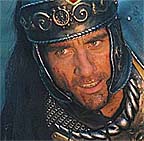 Well, I took off work early yesterday so I could see Bruckheimer's new King Arthur on opening day. I liked this new darker version of Arthur and his knights although I felt the film suffered from some bad film editing trying to fit it into a shorter time slot than it deserved. I think there should have been a more in-depth introduction of characters and examples of experiences that resulted in their bonding as a combat unit and brotherhood that occurred over time as they served together. The film opens with Lancelot being "drafted" and taken from his Sarmatian family as a youth. Then the film jumps ahead 15 years and Arthur and his battle-hardened cavalry are seen riding to the rescue of a bishop traveling to a fort along Hadrian's wall. There is an obvious bond between the men but the viewer is not given any background for this close bond or the legendary exploits that others in the film refer to.
Well, I took off work early yesterday so I could see Bruckheimer's new King Arthur on opening day. I liked this new darker version of Arthur and his knights although I felt the film suffered from some bad film editing trying to fit it into a shorter time slot than it deserved. I think there should have been a more in-depth introduction of characters and examples of experiences that resulted in their bonding as a combat unit and brotherhood that occurred over time as they served together. The film opens with Lancelot being "drafted" and taken from his Sarmatian family as a youth. Then the film jumps ahead 15 years and Arthur and his battle-hardened cavalry are seen riding to the rescue of a bishop traveling to a fort along Hadrian's wall. There is an obvious bond between the men but the viewer is not given any background for this close bond or the legendary exploits that others in the film refer to.
In Gladiator, Ridley Scott illustrates the relationship between Maximus and his men in the opening sequence. You can almost read Maximus' thoughts as he fingers the wheat, smiles at the bird, then his face hardens as he thinks about the battle to come. He passes down the line of his troops, sharing quips, patting armor, obviously respected by his troops as a leader who has shared their lot. He and Quintus discuss the placement of the catapults, clearly establishing Quintus as the second in command and, when Quintus expresses concern about Maximus' safety, demonstrating he is obviously bonded to Maximus as well.
Arthur's director, Antoine Fuqua, leaves the audience guessing about the knights and their relationships to themselves and Arthur. A special relationship between Lancelot and Arthur is slightly inferred but not demonstrated well enough to bring the appropriate level of pathos to the final scenes. Several times throughout the film, Fuqua seems to almost pause the action for a "Kodak" moment. The pauses are so noticeable that I felt they interrupted the flow of the narrative although I must admit I didn't mind at all having a long look at Clive Owen in his Roman attire.
I also thought the sequence where Arthur discovers a Roman noble's bodyguards bricking up a dungeon where Guinevere is being starved to death by monks for her pagan ways while everyone else is fleeing to escape the Saxons (whose drums are heard loudly in the background) a bit contrived. I think it would have been more natural for Arthur and Guinevere to have come into conflict on opposing sides, with Arthur a witness to her warrior skills, then have Arthur get to know her on a personal level when the two sides join to fight the Saxons. As it is, Guinevere is near death when Arthur rescues her. She recovers rather quickly, then is hardly challenged when she announces she is staying with the knights in their delaying action on the frozen lake. Again, I felt there was some insightful film footage that ended up on the cutting room floor. Even so, Guinevere is in a feminine flowing gown during that battle. Later when the Saxons attack the fort, a Guinevere covered with tattoos and sporting a skimpy leather bikini charges into battle and the knights hardly notice the difference.
Of course, I was also a little taken aback that Stellan Skarsgard, my sweet Theseus from the Helen of Troy miniseries, could be such a hardened, merciless warrior.
Overall, however, I liked this version of the Arthur legend better than the fairy tale world of Sir Thomas Mallory. The characters were much more human and believable in their vices and disillusionment that surely were experienced by many Britons during this period of cataclysmic upheaval.
Thursday, July 01, 2004
Boadicea to be featured in four Hollywood Films
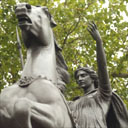 Return of the queen: "Hollywood has four films in development about the British warrior queen. One of them, Warrior, is being produced by Mel Gibson, partly with money from the proceeds of his film The Passion of The Christ (a rare example of fundamentalist Christian money backing a project with a pagan heroine). Along with a DreamWorks project called Queen Fury, Paramount's Warrior Queen and another called My Country, the race is on to get what Variety magazine called 'Braveheart with a bra' to the screen first."
Return of the queen: "Hollywood has four films in development about the British warrior queen. One of them, Warrior, is being produced by Mel Gibson, partly with money from the proceeds of his film The Passion of The Christ (a rare example of fundamentalist Christian money backing a project with a pagan heroine). Along with a DreamWorks project called Queen Fury, Paramount's Warrior Queen and another called My Country, the race is on to get what Variety magazine called 'Braveheart with a bra' to the screen first."
This author seems to think Mel Gibson's version will probably be the most lavish. However, I was concerned that his director's understanding of the Iceni's uprising is a bit spotty. This was also noted by the author:
"Gavin O'Connor, the director enlisted by Mel Gibson to make his Boadicea picture, told Variety last month that he expected his film to buck the trend for female-led epics faring badly at the box office. "What drew me," he said, "is that she was driven by personal revenge. Her goals were never political and never went beyond avenging her slain husband and child. She managed to bring together all of these warring tribes to stand against the Roman empire. It is a masculine story with a female point of view."
It is worth pointing out that Boudicca's husband was not slain by the Romans, nor was her "child". "In fact," says Fraser, "her daughters were raped by the Romans and she was flogged."
Maybe, at least, the costuming will be more authentic, not like the cheap Halloween costumes of PBS' Warrior Queen.
A Brief History of Writing Instuments
 A Brief History of Writing Instuments - Ink and Letters: "The Romans created a reed-pen perfect for parchment and ink, from the hollow tubular-stems of marsh grasses, especially from the jointed bamboo plant. They converted bamboo stems into a primitive form of fountain pen. They cut one end into the form of a pen nib or point. A writing fluid or ink filled the stem, squeezing the reed forced fluid to the nib.
A Brief History of Writing Instuments - Ink and Letters: "The Romans created a reed-pen perfect for parchment and ink, from the hollow tubular-stems of marsh grasses, especially from the jointed bamboo plant. They converted bamboo stems into a primitive form of fountain pen. They cut one end into the form of a pen nib or point. A writing fluid or ink filled the stem, squeezing the reed forced fluid to the nib.
By 400 A.D. a stable form of ink developed, a composite of iron-salts, nutgalls and gum, the basic formula, which was to remain in use for centuries. Its color when first applied to paper was a bluish-black, rapidly turning into a darker black and then over the years fading to the familiar dull brown color commonly seen in old documents."
I was also surprised to learn that the iron stylus Romans used with wax tablets was called a graphium.
“The stylus was also termed graphium (Ovid. Amor. i.11.23; Suet. Jul. 82), and the case in which it was kept graphiarium (Martial, xiv.21) or graphiaria theca (Suet. Claud. 35).
http://www.ukans.edu/history/index/europe/ancient_rome/E/Roman/Texts/secondary/SMIGRA*/Stilus.html
I wonder if this influenced our name for pencil lead – graphite?
Thursday, June 24, 2004
King Arthur -- Artorius or Ambrosius
 The new “King Arthur” movie coming out on July 7 looks more and more exciting – if somewhat creative with historical accuracy. I watched the History Channel’s presentation “The Quest for King Arthur” last week and it does sort of raise some questions. The movie site refers to Artorius but according to the History Channel presentation, Artorius’ men manned Hadrian’s Wall in the second century C.E. not the fifth century C.E. The program pointed to another “last of the Romans”, Ambrosius Aurelianus consistent with this excellent article by Sheila Brynjulfson on the Vortigen Studies website.
The new “King Arthur” movie coming out on July 7 looks more and more exciting – if somewhat creative with historical accuracy. I watched the History Channel’s presentation “The Quest for King Arthur” last week and it does sort of raise some questions. The movie site refers to Artorius but according to the History Channel presentation, Artorius’ men manned Hadrian’s Wall in the second century C.E. not the fifth century C.E. The program pointed to another “last of the Romans”, Ambrosius Aurelianus consistent with this excellent article by Sheila Brynjulfson on the Vortigen Studies website.
"... civil strife erupted as competition for power among rival warlords began:
Kings were anointed not by God, but who should stand out more cruel than the rest, and after a little were murdered by the anointers . .
One, in later accounts called Vortigern, emerged supreme.
Britain's "old enemies," the Picts and the Scots, who had been checked for a time, suddenly launched another fierce attack. Then came the plague. The manpower shortage which gave priority to fighting the Picts left the dead unburied. The invasion threatened to overwhelm them; Vortigern was forced to hire assistance. Gildas told how "the proud tyrant" enlisted the Saxon mercenary forces of two Saxon brothers against the northern raiders:
A council was convened, to decide upon the best and soundest means of withstanding the frequent brutal invasions and raids of the aforesaid peoples. All the members of the council, and the proud tyrant, were struck blind . . .. To hold back the northern peoples, they introduced into the island the vile unspeakable Saxons, hated of God and man alike.
In return for their services, Vortigern gave the Saxons the island of Thanet and goods to support their settlements. Later, reinforcements were imported. The alliance held until the Saxons increased their demand for supplies. When Vortigern would not pay, the Saxons mutinied. They stormed the island, burning towns and cities. Many Britons died; others fled across the Channel to Brittany or were enslaved. Another group retreated to the mountains and dense forests; among these survivors was Ambrosius Aurelianus.
A descendant of a Roman family, Ambrosius organized a coalition of former supporters of the Empire to resist the Saxons."
Maybe the filmmakers wanted the audience to have a hero with a name more similar to Arthur so they chose to use the name of the earlier commander rather than the later one.
See also: King Arthur the Movie
The Quest for King Arthur
Men and Gods in the Rome of the Caesars
"Glory belongs to Greece, while mightiness belongs to Rome -- the ancient saying reflects the overwhelming position of power that ancient Rome once held in the Western world.
Now, that ancient period comes alive again in Men and Gods in the Rome of the Caesars, an exhibition featuring close to 390 cultural relics, ranging from sculptures, goldware to coins, all on loan from six major museums and archeological institutes in Tuscany, Italy.
"The exhibit is one of the museum's biggest shows this year,'' says museum director Chen Xiejun. "Looking at the masterpieces created by the ancient Romans, you can almost hear the noises from the battlefields, the hurly-burly from the markets, whispers from rural households and ritual music from the royal palace.''
Stepping into the exhibition hall, visitors will immediately be drawn by a series of large marble statues. Young or old, man or woman, citizen or noble, all the statues were carved with an extraordinary expertise, creating vivid representations. Portraits were the most unique feature of Roman fine arts, and were used to celebrate the eminent figures of Roman society or as funerary memorials."
The exhibit will move on to the Seoul Museum of History in September.
See: http://www.korea.net/kwnews/news.asp?Number=20040601030
Now, that ancient period comes alive again in Men and Gods in the Rome of the Caesars, an exhibition featuring close to 390 cultural relics, ranging from sculptures, goldware to coins, all on loan from six major museums and archeological institutes in Tuscany, Italy.
"The exhibit is one of the museum's biggest shows this year,'' says museum director Chen Xiejun. "Looking at the masterpieces created by the ancient Romans, you can almost hear the noises from the battlefields, the hurly-burly from the markets, whispers from rural households and ritual music from the royal palace.''
Stepping into the exhibition hall, visitors will immediately be drawn by a series of large marble statues. Young or old, man or woman, citizen or noble, all the statues were carved with an extraordinary expertise, creating vivid representations. Portraits were the most unique feature of Roman fine arts, and were used to celebrate the eminent figures of Roman society or as funerary memorials."
The exhibit will move on to the Seoul Museum of History in September.
See: http://www.korea.net/kwnews/news.asp?Number=20040601030
Friday, June 18, 2004
Transmitting our historical legacy
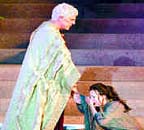 Shakespeare's play "Julius Caesar" is presently being performed in Kansas City and their theater critic, Robert Trussell, made some interesting observations about the importance of Shakespeare’s play in transmitting knowledge of the Roman Empire to successive generations:
Shakespeare's play "Julius Caesar" is presently being performed in Kansas City and their theater critic, Robert Trussell, made some interesting observations about the importance of Shakespeare’s play in transmitting knowledge of the Roman Empire to successive generations:
"Funny thing about Americans. We may not know jack about history, but we've all heard of Julius Caesar.
He has impressed himself on us in movies, plays, comic books, children's literature and endless number of biographies. Photographs of his marble bust have been published around the world.
He has been played by famous actors on stage, in movies and on television. The self-mythologizing would-be ruler of Rome is as famous a name as Nero and Caligula, younger relatives who ruled Rome after Julius slept soundly with the fishes.
But this might not have been the case had a handful of ancient writings, particularly Plutarch's parallel lives of the ancient Greeks and Romans, failed to survive. Or if Sir Thomas North had not translated Plutarch into English. Or if somehow Willie Shakespeare had not gotten around to reading North's translation. Because, friends, whether we're talking about big fat movies or long tedious miniseries or scholarly novels or simplified histories or comic strips, most of what we think we know about the Roman Republic comes from Plutarch through Shakespeare."
He also mentions his first exposure to Shakespeare’s play was in the form of a parody by comedian Brother Dave Gardner:
"On his RCA album Rejoice, Dear Hearts, he delivered his own warped impression of Joseph L. Mankiewicz's 1953 film version of Shakespeare's play with John Gielgud, Marlon Brando and James Mason.
"This is the true story of Julius Caesar if it were presented by the Down Home Players," Brother Dave enunciated in his unique Southern patois. "Now the mighty Caesar have returned from a quail-huntin' trip down in South Carolina and on his arm is Mark Antony...and Mark Antony speaks to the might' Caesar in his fluent Roman Italian voice and he say, 'Hey, Julius.' "
In 15 minutes of verbal gags and trippy digressions Brother Dave offered a fairly accurate summary of the first part of the play, paraphrasing Shakespeare at will.
"Let me have me them fat sleek-headed cats that sleeps all the time and eats all the time and don't never think about nothin'," Brother Dave's Caesar tells Antony, later expressing his distrust of Cassius: "He nibbles them No-Doze and drinkin' that Air Wick and sits in that little house away from the house and meditates. Oh, he thinks too much. He 'bout half-smart."
http://www.kansascity.com/mld/kansascity/entertainment/music/8947332.htm
I guess if a work is skewed this much and still instigates an interest in the real history, we shouldn’t be too critical of Hollywood’s recent efforts!
- Libitina
Wealth and the afterlife in the Classical World
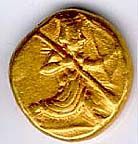 I was reading yet another discussion on the latest Troy film where archaeologists point out that coins were not placed on the eyes of the dead at that time because coins were not invented for another 500 years. I, too, had read that many academicians credit King Ardys of Lydia with minting the first coins in the 7th century B.C.E. and King Croesus with standardizing government-issued coinage However, I found this website about the history of coinage that states the first metallic coins, made of bronze and shaped like cattle, date back to approximately 2000-1800 B.C.E.
I was reading yet another discussion on the latest Troy film where archaeologists point out that coins were not placed on the eyes of the dead at that time because coins were not invented for another 500 years. I, too, had read that many academicians credit King Ardys of Lydia with minting the first coins in the 7th century B.C.E. and King Croesus with standardizing government-issued coinage However, I found this website about the history of coinage that states the first metallic coins, made of bronze and shaped like cattle, date back to approximately 2000-1800 B.C.E.
"The first metallic money dates back to approximately 2000-1800 BC and was made of bronze. These bronze pieces which traded based on weight, were often formed into the shape of cattle, which again were used prior to the general acceptance of metals as a valuable commodity. The primary reason behind the origins of coinage is a matter open for debate. One school of thought is that the first coins were struck for religious reasons.
Another suggests that they were made solely in order to help facilitate trade. Still another theory promotes the idea that man began making coins strictly for accounting and administrative reasons."
http://www.coin-gallery.com/cgearlycoins.htm
Original criticism also got me to thinking about changes in Greek religion from the time of the Trojan War to the classical period. At what point was the payment of the ferryman across the River Styx introduced? Was this introduction into Greek religion an effort by the wealthy to ensure that they did not have to mingle with the abject poor in the afterlife?
Wednesday, June 16, 2004
Turning Pages and the power of illustration
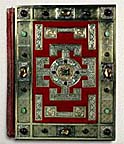 Turning the Pages: Peter Williams, a fellow blogger who, as a member of the Association of Roman Archaeology, also produces a web log on the topic, recently mentioned a fascinating new project by the British Library called Turning Pages.
Turning the Pages: Peter Williams, a fellow blogger who, as a member of the Association of Roman Archaeology, also produces a web log on the topic, recently mentioned a fascinating new project by the British Library called Turning Pages.
"Turning the Pages is the award-winning interactive program that allows museums and libraries to give members of the public access to precious books while keeping the originals safely under glass. Initially developed by and for the British Library, it is now available as a service for institutions and private collectors around the world.
Turning the Pages allows visitors to virtually 'turn' the pages of manuscripts in a realistic way, using touch-screen technology and interactive animation. They can zoom in on the high- quality digitised images and read or listen to notes explaining the beauty and significance of each page. There are other features specific to the individual manuscripts. In a Leonardo da Vinci notebook, for example, a button turns the text round so visitors can read his famous 'mirror' handwriting."
I particularly enjoyed the detailed depictions of medieval life in the LUTTRELL PSALTER and the beautifully illustrated 14th century Hebrew manuscript, GOLDEN HAGGADAH.
The other day a friend and I were discussing the distressing trend of sparse illustration, especially in academic texts, and pondered whether this a result of simple economics or a growing cultural concern with "appropriate" images and various censorship movements.
Tuesday, June 15, 2004
Waters of the City of Rome
Waters of the City of Rome: "During the Age of the Kings (ca. 625 - 509BC), the landscape was dramatically transformed by the construction of a large drain called the Cloaca Maxima. This drain collected the waters from the living stream, refered to as the Forum Brook, which flowed into the valley between the Palatine, Quirinal, and Capitoline Hills, thus drying out the seasonally marshy area that was later occupied by the Forum Romanum. 'Living water', that is the water flowing from a natural spring, was considered sacred and was not included within the newly constructed protective walls that surrounded the plateau of the Palatine hill. Another drain, the Cloaca Circus Maximus, was constructed during the 'Age of the Kings' in order to drain the area to the south of the Palatine where games were held. The first bridge across the Tiber River, the Pons Sublicius, was constructed during this period."
Friday, May 28, 2004
A proper Roman Eulogy
Menander the Orator (c. ad 300), who is very sound on how to eulogise a harbour, suggests the following for a great man’s funeral. It all sounds quite ghastly. Encomia of the dead person, he tell us, should be based on the following topics: family, birth, nature, nurture, education, accomplishments, actions, Fortune, ending with consolation. Under ‘family’, the eulogist must stress that there is none more brilliant in the city. ‘Birth’ is an important topic if a child has died: mention the rejoicing of the whole family, the splendid hopes, the prospect of a great destiny, all dashed by fate. ‘Nature’ should cover physical beauty and mental endowment; ‘nurture’ should touch on the speed with which the person developed; ‘education’ should stress that he was far ahead of his contemporaries; ‘accomplishments’ should deal with his fairness, humanity, approachability and gentleness. ‘Actions’, what the person achieved in life, is the topic that Menander suggests the eulogist should concentrate on, and he should point out that Fortune followed him all his life so that he was wealthy, loved by his friends, honoured by the great and good, and so on. Throughout, Menander goes on, the dead person must be shown to have been fit to rival any man in distinction.
Thursday, May 20, 2004
When in Rome
With all the current interest in the ancient world stirred up by such movies as "Gladiator" and "Troy", the regional government along with two historical societies is offering free Latin classes to tourists in a bid to lure even more of the sword-and-sandals loving crowd to Rome.
'Given all the excitement over the Roman Empire lately, we thought it was crazy not to do something here in the heart of it all,' said Alessandro Pediconi, one of the organisers.
The first courses are being offered for English and French speaking tourists using a comic book starring 'Caesar' and featuring cursory history and language lessons.
For those itching to really live the Roman experience, organisers plan to team up this summer with the Scuola Gladiatori Roma, or gladiator school, to offer a package with Latin classes and a crash course in gladiator fighting.
After donning tunics and helmets, tourists would also be treated to a typical Roman feast."
'Given all the excitement over the Roman Empire lately, we thought it was crazy not to do something here in the heart of it all,' said Alessandro Pediconi, one of the organisers.
The first courses are being offered for English and French speaking tourists using a comic book starring 'Caesar' and featuring cursory history and language lessons.
For those itching to really live the Roman experience, organisers plan to team up this summer with the Scuola Gladiatori Roma, or gladiator school, to offer a package with Latin classes and a crash course in gladiator fighting.
After donning tunics and helmets, tourists would also be treated to a typical Roman feast."
Tuesday, May 18, 2004
Roman Marching Camps Used by Offensively and Defensively
There is an interesting article on Roman fortifications in this month’s issue of Military Heritage magazine. The author, Arnold Blumberg, takes issue with the conclusions of J.F.C. Fuller and Liddell Hart that the practice of entrenching each day slowed the Romans down to the point that they seldom had a chance to select advantageous positions for pending battles. Blumberg said that as far as Fuller was concerned, Roman warfare was little more than “mobile trench warfare” requiring them to always assume “the strategic and operational defensive”.
Blumberg says strategically, marching-camps proved to be an aggressive military instrument. He observed that not only were these displays of “massive military power” demoralizing to the enemy but that fortifications left in the wake of an advancing army served as stepping stones to sustain the army’s movements. Many were transformed into permanent fortified positions that became centers of territorial administration and troop staging areas protecting communication lines.
He says there are a number of examples of marching camps employed both offensively and defensively. He cites the battle of the Sambre River in 57 B.C.E. between Julius Caesar’s troops and the Belgae. The Gauls launched a surprise attack on the Roman camp but the legionaries used the camp as a protective screen for their flank and rear, pivoted, and routed the enemy.
Labienus reversed the strategy in Trier, Germany in 54 B.C.E.. “He unleashed a double flanking attack against the army of the Treveri. He sent his cavalry storming out of the front and rear gates of the compound on a devastating charge that killed the rebel leader and caused the collapse of the Gallic uprising,” Blumberg says.
He also pointed out that contrary to claims that building a camp slowed the Roman armies down, the Romans averaged 20 miles per day. On the other hand, Gallic and Germanic war bands usually included many more women, children and livestock herds, averaging only three to nine miles per day.
See also: Roman Camps
Blumberg says strategically, marching-camps proved to be an aggressive military instrument. He observed that not only were these displays of “massive military power” demoralizing to the enemy but that fortifications left in the wake of an advancing army served as stepping stones to sustain the army’s movements. Many were transformed into permanent fortified positions that became centers of territorial administration and troop staging areas protecting communication lines.
He says there are a number of examples of marching camps employed both offensively and defensively. He cites the battle of the Sambre River in 57 B.C.E. between Julius Caesar’s troops and the Belgae. The Gauls launched a surprise attack on the Roman camp but the legionaries used the camp as a protective screen for their flank and rear, pivoted, and routed the enemy.
Labienus reversed the strategy in Trier, Germany in 54 B.C.E.. “He unleashed a double flanking attack against the army of the Treveri. He sent his cavalry storming out of the front and rear gates of the compound on a devastating charge that killed the rebel leader and caused the collapse of the Gallic uprising,” Blumberg says.
He also pointed out that contrary to claims that building a camp slowed the Roman armies down, the Romans averaged 20 miles per day. On the other hand, Gallic and Germanic war bands usually included many more women, children and livestock herds, averaging only three to nine miles per day.
See also: Roman Camps
Monday, May 10, 2004
Acting Troupe Dedicated To Making History Interesting
"Stewart Hulme's mobile Bluesilver Theatre company is now bringing history alive to schools across the North and Midlands with his plays about key phases in time accompanied by just three other actors, a minimum of props and an extremely tightly-packed Vauxhall Vectra estate.
After participating in No Pasaran (They Shall Not Pass), a play about the persecution of Jews in Nazi Germany, Hulme designed his first play for schools, Moved East, about the rise of Facism in Germany in the 1930s and its effect upon three young people living there. He began studying the national curriculum, carrying out self-styled market research among teachers about what were the favoured topics.
This spawned three other plays: The Great Dying about the Black Death epidemic in medieval Europe, A Spin o' The Wheel which deals with the Industrial Revolution and Speakeasy, focusing on the prohibition years and the Great Depression in 1930s America.
These 90-minute creations are all primarily designed for secondary schools and are proving to be extremely popular with both the teachers - and more importantly the pupils.
Another actress, Helena Jacks, from Woolton, joins Stewart for the Living Theatre performances, a series of plays written for primary schools by Jean and Peter Davies, from Great Budworth in Cheshire, from whom Bluesilver acquired the rights to perform.
These are far more interactive allowing the children to supplement the acting roles not covered by either Stewart or Helena.
For instance in Tudor Times, Stewart plays Henry VIII and a selection of pupils represent his Six Wives.
In another, The Ancient Greeks, pupils play the soldiers erupting from the Trojan Horse to rescue Helen (Helena).
"The kids really enjoy it," says Stewart. "And we do get through a lot of plastic axes and swords!"
Like Mr. Hulme, I've always been disappointed in history classes that seem to dehumanize a fascinating subject by emphasizing the memorization of names and dates. I think his creative solution to the problem a commendable one.
After participating in No Pasaran (They Shall Not Pass), a play about the persecution of Jews in Nazi Germany, Hulme designed his first play for schools, Moved East, about the rise of Facism in Germany in the 1930s and its effect upon three young people living there. He began studying the national curriculum, carrying out self-styled market research among teachers about what were the favoured topics.
This spawned three other plays: The Great Dying about the Black Death epidemic in medieval Europe, A Spin o' The Wheel which deals with the Industrial Revolution and Speakeasy, focusing on the prohibition years and the Great Depression in 1930s America.
These 90-minute creations are all primarily designed for secondary schools and are proving to be extremely popular with both the teachers - and more importantly the pupils.
Another actress, Helena Jacks, from Woolton, joins Stewart for the Living Theatre performances, a series of plays written for primary schools by Jean and Peter Davies, from Great Budworth in Cheshire, from whom Bluesilver acquired the rights to perform.
These are far more interactive allowing the children to supplement the acting roles not covered by either Stewart or Helena.
For instance in Tudor Times, Stewart plays Henry VIII and a selection of pupils represent his Six Wives.
In another, The Ancient Greeks, pupils play the soldiers erupting from the Trojan Horse to rescue Helen (Helena).
"The kids really enjoy it," says Stewart. "And we do get through a lot of plastic axes and swords!"
Like Mr. Hulme, I've always been disappointed in history classes that seem to dehumanize a fascinating subject by emphasizing the memorization of names and dates. I think his creative solution to the problem a commendable one.
Monday, May 03, 2004
Authenticating ancient 7-inch barbarian proves to be an epic quest
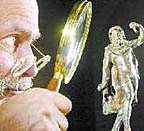 "Nineteen years ago, Robert Cohon strode through the classical galleries of the Nelson-Atkins Museum of Art in Kansas City, Mo. The light was low. The room was quiet. A spotlighted statue in a display case stopped Cohon in his tracks.
"Nineteen years ago, Robert Cohon strode through the classical galleries of the Nelson-Atkins Museum of Art in Kansas City, Mo. The light was low. The room was quiet. A spotlighted statue in a display case stopped Cohon in his tracks.
The barbarian was only 7 inches tall, but, Cohon says, 'it was spectacular.'
The nude figure had muscular legs and a cape. It held the right hand high, the other low, as if carrying a shield and a weapon. The dark bronze surface was mottled with tiny patches of red and green patinas. With its twisted posture, the look on its face and a bandaged leg, the barbarian appeared wounded and in pain.
To someone steeped in the art of ancient cultures, this small bronze statue of a warrior was quite a prize. Its presence at the museum helped Cohon decide to take a job as the Nelson's curator of antiquities.
Yet, within a couple of years, his elation turned to doubt amid questions about the figure's authenticity.
Could it really be 2,000 years old? Or was it of more recent vintage - from the Renaissance, say, or even a forgery?
The barbarian appeared to be left handed and the barbarian's face was Christlike, with flowing locks and a goatee. His thigh was bandaged, also an unusual detail for 2nd century Roman depictions of conquered barbarians.
Now, 17 years later, Cohon has pieced together the truth, and in April, for an audience in a Nelson-Atkins auditorium, he revealed what he learned about the little bronze warrior and the thrills of archaeology."
New Interpretation Panels Installed at Roman Fort of Cramond
 "Between 208 and 212AD, the African-born Roman Emperor Septimus Severus chose Cramond as a key base to lead the last major campaign of Roman conquest in Scotland.
"Between 208 and 212AD, the African-born Roman Emperor Septimus Severus chose Cramond as a key base to lead the last major campaign of Roman conquest in Scotland.
In the last years of his reign, Severus travelled to Scotland where there were uprisings against the Roman Empire. He restored Hadrian's Wall and helped to strengthen the Romans' power in Britain again.
Severus built his fort on an existing Roman military settlement which was established around 140AD during earlier campaigns. He died in 212AD in York.
Now, new interpretation panels provide visitors with a fascinating insight into life at the 1800-year-old fort near Cramond Kirk, which was designed to help protect the empire's western flank, and at the nearby bathhouse, described as one of the best surviving Roman buildings north of the Border. The remains of the Roman fort are explored in detail on three of the information panels, which focus on the occupation of the fort during the third century AD.
The panels depict the fort within the landscape of the time, showing the harbour and also the large defended settlement attached to the fort’s eastern side.
The Roman remains are described by archeologists as of 'huge historical importance', and sit close to the River Almond site where a ferryman discovered the celebrated Cramond Lioness."
Wednesday, April 21, 2004
Spartacus remake follows history more closely than original
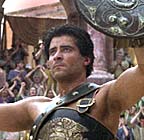 Sunday and Monday, USA Networks broadcast their remake of "Spartacus". I must admit that the remake was much more true to history in many respects than the Kirk Douglas version. I wondered if they would include the incident where Spartacus crucified a Roman soldier in view of the Romans to display his own ruthlessness and determination and by golly, they did! They also showed Spartacus as a somewhat hesitant leader and correctly portrayed the conflict between him and Crixus. Crixus also broke away with his Gauls and was slaughtered by the Romans as really occurred in history. I'm afraid the actor playing Spartacus just didn't have the intensity of Kirk Douglas though.
Sunday and Monday, USA Networks broadcast their remake of "Spartacus". I must admit that the remake was much more true to history in many respects than the Kirk Douglas version. I wondered if they would include the incident where Spartacus crucified a Roman soldier in view of the Romans to display his own ruthlessness and determination and by golly, they did! They also showed Spartacus as a somewhat hesitant leader and correctly portrayed the conflict between him and Crixus. Crixus also broke away with his Gauls and was slaughtered by the Romans as really occurred in history. I'm afraid the actor playing Spartacus just didn't have the intensity of Kirk Douglas though.
There was no hint of homosexuality in Crassus (although I questioned the proliferation of beards - including Crassus). The Romans did not use stirrups (you see Crassus jumping down from his mount without their aid). I did wonder about the Roman uniforms, though, as the legionaries wore leggings which I thought was not adopted until after Caesar invaded Gaul. They also included the conflict between Crassus and Pompey and how Pompey tried to claim the victory over Spartacus for himself. In a brief scene in front of the senate, we also see Julius Caesar acting as the "mediator" to reconcile Crassus and Pompey with a joint consulship and the "pregnant" looks between a smug Caesar and the old senator attempting to manipulate events to his own advantage.
Thursday, April 01, 2004
Killer Queens New Series on The History Channel
 In the first of this new six part series about famous women rulers, presenter Rory McGrath takes us on an entertaining and bloody romp through the Boudiccan revolt against the Romans. We learn how the defiant Iceni Queen was flogged by the Romans and her daughters raped and how in turn this led to her vengeful massacre of the entire Roman population of Colchester. Continues next week as Boudicca takes on the whole Roman Army.
In the first of this new six part series about famous women rulers, presenter Rory McGrath takes us on an entertaining and bloody romp through the Boudiccan revolt against the Romans. We learn how the defiant Iceni Queen was flogged by the Romans and her daughters raped and how in turn this led to her vengeful massacre of the entire Roman population of Colchester. Continues next week as Boudicca takes on the whole Roman Army.
Wednesday, March 31, 2004
Roman Funerary Sculpture Featured in New Exhibit
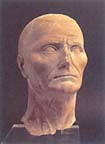 "A new exhibit at the National Museum of Western Art in Tokyo features Roman funerary sculpture gleaned from the collection of the Vatican Museum. The tradition of funerary portraiture grew out of elite practices during the years predating Augustus' epochal Pax Romana, the era of (relative) peace brought about by Roman domination of the Mediterranean region. In those early years -- the literary heyday of Rome (the first century B.C. produced Virgil, Horace, Ovid and Livy) -- wax portraits known as imagines would be paraded in the funeral processions of the upper classes. These would then be displayed, perhaps alongside portraits or busts in bronze, marble or terracotta, in the lararium (household shrine), not unlike the way photographs of ancestors are displayed to this day on the butsudan (family altar) in many Japanese homes.
"A new exhibit at the National Museum of Western Art in Tokyo features Roman funerary sculpture gleaned from the collection of the Vatican Museum. The tradition of funerary portraiture grew out of elite practices during the years predating Augustus' epochal Pax Romana, the era of (relative) peace brought about by Roman domination of the Mediterranean region. In those early years -- the literary heyday of Rome (the first century B.C. produced Virgil, Horace, Ovid and Livy) -- wax portraits known as imagines would be paraded in the funeral processions of the upper classes. These would then be displayed, perhaps alongside portraits or busts in bronze, marble or terracotta, in the lararium (household shrine), not unlike the way photographs of ancestors are displayed to this day on the butsudan (family altar) in many Japanese homes.
Roman funerary monuments from the third century and fourth century A.D. show declining levels of artistic skill.
One of the most powerful pieces here is the head of a terracotta votive statue dating from the first quarter of the first century A.D.; the face is aquiline and patrician, seeming to anticipate the so-called hieratic style of later centuries. Or, rather, hieratic representation, which evolved in the third century, was a conscious effort to recapture the stylistic purity of such early Roman sculpture, after two centuries of cheerfully expressive but unrefined representation -- as exemplified by those tradesmen's funerary friezes. "
Tuesday, March 30, 2004
The Mithraic Mysteries
 "Closed for six years, the planetarium at the Rosicrucian Egyptian Museum has reopened with a show on the skies of 2020 B.C., the cusp of a celestial shift that spawned one of the major competitors of early Christianity.
"Closed for six years, the planetarium at the Rosicrucian Egyptian Museum has reopened with a show on the skies of 2020 B.C., the cusp of a celestial shift that spawned one of the major competitors of early Christianity.
The star show "The Mithraic Mysteries'' explores a secretive ancient religion that has been a particular enigma for archaeologists and historians. It takes viewers through the steps that led a San Francisco scholar of ancient religions to theorize that changes in the night sky formed the basis for Mithraism, practiced throughout the Roman Empire in the first centuries A.D.
The reinauguration of the planetarium at the popular San Jose tourist attraction -- with its Egyptian revival buildings and gardens and mummy- and artifact-filled museum -- is the first of many renovations this year at the 77-year-old Rosicrucian Park complex. Planned renovations include an authentic 18th-dynasty Egyptian Peace Park that will have a small temple, viewing dais, sycamore fig, grape arbor and dhoum palms surrounding a reflecting pond."
Monday, March 22, 2004
Byzantium: Faith and Power Exhibit Opens at the Met
 "A landmark exhibition featuring three centuries of Byzantine culture opens tomorrow at the Metropolitan Museum of Art in New York. Seven years of research, negotiations, and collaboration have brought together 377 artifacts from 27 countries -- among them Russia, Bulgaria, Serbia and Montenegro, Romania, Macedonia, Egypt, Greece, and Turkey. Many of the masterpieces are borrowed from churches and monasteries, and have never been exhibited before.
"A landmark exhibition featuring three centuries of Byzantine culture opens tomorrow at the Metropolitan Museum of Art in New York. Seven years of research, negotiations, and collaboration have brought together 377 artifacts from 27 countries -- among them Russia, Bulgaria, Serbia and Montenegro, Romania, Macedonia, Egypt, Greece, and Turkey. Many of the masterpieces are borrowed from churches and monasteries, and have never been exhibited before.
'Byzantium: Faith and Power' exhibit covers the period when Constantinople resumed its role as a cultural and political center of the Eastern Roman Empire until 1557. "
Wednesday, March 17, 2004
Winged sandals
 "If multi-media mythology sounds appealing, simply strap on a pair of Winged Sandals. As those who still remember their Greek mythology will know, the site's title refers to the unique footwear of Hermes, messenger of the gods (and more recently, upscale clothing and accessories retailer). The artist's interpretation of the immortal emissary, and the messenger's 'Alvin and the Chipmunks' voice make it clear at the outset that this is a site primarily designed to introduce children to its subject matter. (The target age is 6-12 years old.) But while the information is appropriately rudimentary, interested adults can still get a quick refresher course, and won't be bored while supervising their children's visits. (The Australian Broadcasting Corporation production won best e-learning site and best in show at the annual Australian Interactive Media Association awards in February.)
"If multi-media mythology sounds appealing, simply strap on a pair of Winged Sandals. As those who still remember their Greek mythology will know, the site's title refers to the unique footwear of Hermes, messenger of the gods (and more recently, upscale clothing and accessories retailer). The artist's interpretation of the immortal emissary, and the messenger's 'Alvin and the Chipmunks' voice make it clear at the outset that this is a site primarily designed to introduce children to its subject matter. (The target age is 6-12 years old.) But while the information is appropriately rudimentary, interested adults can still get a quick refresher course, and won't be bored while supervising their children's visits. (The Australian Broadcasting Corporation production won best e-learning site and best in show at the annual Australian Interactive Media Association awards in February.)
Of the site's various sections, Storytime is the most engaging, as it recounts legends that include Perseus' battle with the Medusa, and Orpheus' journey into the underworld to rescue his beloved Eurydice. Each story includes a 'cast list,' which links to specific biographies on each character, including a few lines of text, keyword list (mortal/immortal, female/male, etc.), a family tree, and -perhaps one of the most useful features at the site- the ability to hear the proper pronunciation of each character's name. (Someone who has never been properly introduced to Eurydice or Antigone might make reasonable but wildly incorrect assumptions about inflections -yuri-dice? anti gone?- and find themselves banned from Mount Olympus' better parties.)"
Winged Sandals can be found at http://www.wingedsandals.com/
Thursday, March 11, 2004
Appius Claudius Caecus and the letter Z
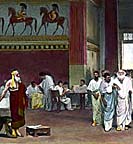 "The Latin alphabet derived from the Etruscan, which was adopted from the Greek of colonists who had settled at Cumae in Campania. An indication of this borrowing is that the sound of k was conveyed by three different letters: gamma (G) before e and i, kappa (K) before a, and koppa (Q) before u. (Indeed, that is their names: ce, ka, qu). In Latin, kappa soon became redundant, except in the archaic spelling of such words as Kalendae (the first day of the Roman month), and was dropped from the alphabet. And Q was restricted to cases in which it preceded u. Principally, it was gamma, the third letter in the Greek alphabet and represented by the letter C in Latin, that conveyed the sound of k.
"The Latin alphabet derived from the Etruscan, which was adopted from the Greek of colonists who had settled at Cumae in Campania. An indication of this borrowing is that the sound of k was conveyed by three different letters: gamma (G) before e and i, kappa (K) before a, and koppa (Q) before u. (Indeed, that is their names: ce, ka, qu). In Latin, kappa soon became redundant, except in the archaic spelling of such words as Kalendae (the first day of the Roman month), and was dropped from the alphabet. And Q was restricted to cases in which it preceded u. Principally, it was gamma, the third letter in the Greek alphabet and represented by the letter C in Latin, that conveyed the sound of k.
But C also had the sound of g and, since gamma already represented k, a new letter was added to distinguish between these two values. Plutarch (Quaestiones Romanae, 54, 59) attributes its introduction (in the third century BC) to Spurius Carvilius Ruga, a freedman whose grammar school was the first to charge a fee (he also was the first Roman to divorce his wife). The letter continued to represent the sound of k but, by adding a stroke to C, Carvilius created the letter G to denote that sound. Its older value survived, however, in the abbreviations for Gaius (C.) and Gnaeus (Cn.). The seventh letter in the Latin alphabet, G took the position originally held by Z (zeta), which had no equivalent value in Latin and was discarded.
The introduction of the new letter also has been attributed to Appius Claudius Caecus, Roman censor in 312 BC. According to Martianus Capella (De Nuptiis Philologiae et Mercurii, III.261), 'Z was abhorrent to Appius Claudius, because it resembles in its expression the teeth of a corpse,' that is, in sounding the letter the lips pulled over the teeth looked much as they would in the rigor of death. More prosaically, the loss of Z may have been due to rhotacism, in which the s sound it represented was transferred to r (for example, Fusius becoming Furius), a replacement that consequently made the letter unnecessary."
Augustus' Program of Cultural Renewal
 By Paul Zanker
By Paul Zanker
"At the same time as his 'restoration of the Republic' and the creation of his new political style, Augustus also set in motion a program to 'heal' Roman society. The principal themes were renewal of religion and custom, virtus, and the honor of the Roman people. Never before had a new ruler implemented such a far-reaching cultural program, so effectively embodied in visual imagery; and it has seldom happened since. A completely new pictorial vocabulary was created in the course of the next twenty years. This meant a change not only in political imagery in the narrow sense, but in the whole outward appearance of the city of Rome, in interior decoration and furniture, even in clothing. It is astonishing how every kind of visual communication came to reflect the new order, how every theme and slogan became interwoven. Again, however, there was no master plan outlining some sort of a propaganda campaign for the revival of Rome. As in the development of imagery after Actium, much happened as if of its own accord, once the princeps had shown the way and taken the first steps.
Augustus did not need to formulate a new program himself; it had already been done for him. For generations the ills of state and society had been proclaimed, described, and lamented as incurable evils. The surprising thing, for many people virtually a miracle, was that the new ruler actually took the lament seriously and decided to do something about it. He was utterly irrepressible as he set about addressing, in terms of concrete policies, all the problems that he had himself decried back in the 30s B.C., immediately creating the foundation on which he would build his programs. In the next sections we shall observe the remarkable confidence--one might almost say naivete--with which he went about building on that framework, step by step, going through the whole catalog of ills left over from the Late Republic, until in 17 B.C. he could sail the rebuilt ship of state into a safe harbor called the Golden Age.
It started with the program of religious revival in 29 B.C. There followed efforts toward publica magnificentia and the restoration of Roman virtus in the Parthian campaign of 20 B.C. Two years later, in 18, with the Romans’ confidence in their ability to rule an empire now bolstered, a legally imposed moral renewal was required. This completed the internal overhaul of Rome, and nothing now stood in the way of the new Golden Age. Nothing could be simpler!
At first, of course, each of these points in the Augustan program amounted to little more than one of the old slogans. They were statements of intention, which then had to be realized in action and in architecture and the visual arts. The princeps would need the help and cooperation of many. Since no written source gives us a picture of how the complex machinery of this cultural program actually worked, we must try to infer from the results themselves an idea of the collaboration and the mutual influence on one another of princeps, political cronies, creative poets, architects, and artistic ateliers."
The McMasters Trajan Project
 "From the earliest days of the city, the hub of Roman business, politics, and ceremony had been the Forum Romanum. Located at the base of the Palatine hill just south of the capital, the Forum Romanum was embellished over the years with temples, places of meeting and business, and various honours to famous citizens. Here, politicians debated, citizens met, talked, and voted, priests made sacrifices, and triumphant generals rode through on their way to the Capitol. On special occasions, gladiators even fought to the death while spectators looked on from temporary wooden stands. By the time of Caesar, however, the old forum was no longer large enough to handle all the business which needed to be transacted. Some of these activities were moved elsewhere: for example, new facilities for voting were constructed on the Campus Martius, removing a major political function of the old Forum. The other approach to this problem of space was to construct supplementary venues nearby. Caesar, Augustus, and Nerva each built new fora to the north east of the old Forum, but still linked to it and to each other by doors and passageways. Domitian is said to have started construction on a fourth imperial forum, but work on this ceased at his death. Thus, it was left to Trajan to fill the need for yet more forum space. Trajan did more, however, than simply provide more space for the public business of Rome; he constructed at the same time a monument to himself and to the glory of the Empire.
"From the earliest days of the city, the hub of Roman business, politics, and ceremony had been the Forum Romanum. Located at the base of the Palatine hill just south of the capital, the Forum Romanum was embellished over the years with temples, places of meeting and business, and various honours to famous citizens. Here, politicians debated, citizens met, talked, and voted, priests made sacrifices, and triumphant generals rode through on their way to the Capitol. On special occasions, gladiators even fought to the death while spectators looked on from temporary wooden stands. By the time of Caesar, however, the old forum was no longer large enough to handle all the business which needed to be transacted. Some of these activities were moved elsewhere: for example, new facilities for voting were constructed on the Campus Martius, removing a major political function of the old Forum. The other approach to this problem of space was to construct supplementary venues nearby. Caesar, Augustus, and Nerva each built new fora to the north east of the old Forum, but still linked to it and to each other by doors and passageways. Domitian is said to have started construction on a fourth imperial forum, but work on this ceased at his death. Thus, it was left to Trajan to fill the need for yet more forum space. Trajan did more, however, than simply provide more space for the public business of Rome; he constructed at the same time a monument to himself and to the glory of the Empire.
The two main elements of the new Forum of Trajan were an open piazza and a basilica, and both were astonishingly large. The entire Forum of Nerva would have fit within the basilica, and the piazza, its open area alone measuring more than 80m in width and 120m in length, was large enough to hold almost the entire Forum of Augustus. This piazza, the heart of the Forum, was paved with imported marbles and surrounded by a colonnade. Atop this colonnade were inscriptions stating that the whole complex had been built using the spoils of war taken by the emperor. One of the functions of this massive open space was to provide a setting for public business and ceremony. For example, the successor of Trajan, Hadrian, performed in it a great ceremony of burning debt records. Later, during a time of dire military need, the emperor Marcus Aurelius used it as a venue for a great auction of the imperial possessions. Another function was to provide a display area in which to exhibit honours to great Romans. Naturally, the greatest honour went to Trajan himself, who was immortalised by a great equestrian statue, cast in bronze, gilded, and placed atop a pedestal in the centre of the piazza. The size of this statue was so great that it defied replication by any later rulers. When the emperor Constantius visited the Forum of Trajan in the 4th century, he declared somewhat rashly that he would order a copy of this horse to be made. One of his companions, a Persian prince named Ormisda, replied wittily that first the emperor should build a new stable, if he could, so that the proposed new steed might roam as freely as the one they saw before them. The base of this statue has recently been discovered in the centre of the Forum piazza, and its measurements give us an idea of the size of the horse which Constantius desired to copy: the horse and rider together (not including the base) may have been as much as 12 metres tall. By comparison, the famous equestrian statue of Marcus Aurelius, which now stands on the Capitol, is only about one third as large.
Beyond the eastern end of the piazza was a multi-level market, in which spices and other luxuries were sold. The solid brickwork of this structure has proven so enduring that, except for the column, it is today the best preserved element of the forum complex. The north end of the piazza was dominated by the basilica. Its huge interior space (120m by 55m) was covered by a timber and tile roof supported on a forest of massive columns, and was enlarged by the provision of apses at each end. Its decoration was sumptuous. The walls and floor were clad in marble, and the roof was covered with bronze tiles thickly gilded. This sheltered yet extremely imposing space would have provided a suitable setting for public business, especially important trials. The dual apses, unusual for a Roman basilica, may have been added to double the space available for such affairs.
When finally sated with the sights of the grand piazza, exhausted by the bustle of the market, and overwhelmed by the fervent pleading of the advocates in the basilica, a visitor could exit the north side of the basilica and enter a much different environment. Walking out through the last row of imposing columns, our visitor would emerge into a small courtyard on the other side of the basilica. This courtyard was flanked to the west and east by two libraries, one for Latin and one for Greek texts. It is not certain what lay to the north. A temple to the divine Trajan has been suggested, but no remains of such a building have been found in this area. However, a visitora's attention would be immediately drawn to the imposing monument which stood in the centre of the court: the column of Trajan."
Thursday, February 26, 2004
Scipio Africanus: The Man and the Model
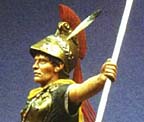 by Greg DiFranco
by Greg DiFranco
It was 211 BC and the two most powerful city-states of their time were locked in the mortal combat of the Second Punic War. It was the wealthy maritime power of Carthage pitted against Republican Rome. By now Carthage had brought Rome to the brink of total destruction, and arguably to the lowest point in its history. Hannibal and his fellow commanders had successfully defeated many Roman armies, and had completely annihilated a number of them in the process. Most notable was Hannibal’s annihilation of one of the largest armies Rome had ever assembled (70,000 troops) at the battle of Canne. Many of Rome’s most prominent citizens were lost in this battle, as in keeping with Republican Roman tradition, the most important citizens fought in the front ranks. The city of Rome itself was left almost helplessly exposed and was in chaos with the expectation of a siege. And if things weren’t desperate enough for the Romans, the Carthaginians now took complete control of Iberia (Spain), one of the most important economic areas of the region. In the process two of the most highly respected and admired Roman commanders were killed on the same day, they were the Scipio brothers. Although Rome fielded formidable armies, armies that in fact had beaten Carthage in the first Punic wars, they were proving no match for Hannibal’s troops and tactics. Rome fielded a non-professional citizen army with rather static legionary tactics based on breaking the enemy’s center, and without a strong cavalry contingent. On the other hand, Hannibal had successfully trained and honed an array of professional foot and mounted troops from African, Iberian (Spain) and Celtic stock, into a superior fighting force capable of flexible tactical maneuvers. To this he applied brilliant tactics, including classic flanking maneuvers the Roman legions were unable to counter.
Somehow, in the middle of the carnage that was Rome’s defeat at Canne, the young son of Scipio the Elder managed to survive. In an unprecedented move, the desperate Romans elected this young patrician to lead the remnants of the Roman army in Spain, he was just in his early twenties. Young Scipio immediately exhibited an uncanny ability for leadership and quickly set about retraining and improving the moral of the defeated Roman army of Spain. With the winter season as his respite, Scipio began laying plans for correcting the Roman legions weaknesses, and laying the groundwork for an army that could match Hannibal’s. No detail was left unattended, from the complex work of adding flexibility to legionary level tactics, to strengthening man to man fighting techniques, to details such as which sword would be most effective in close quarter combat.
Attila and the legacy of the Huns
 "Perhaps no other people have struck greater fear in the west than the Huns. In the end of the fourth century the Huns seemed to have materialized out of nowhere and crushed they way into the Hungarian plains. From there they extended their domains south of the Danube River, into Gaul and then northern Italy, leaving a trail of destruction and terror wherever they went.
"Perhaps no other people have struck greater fear in the west than the Huns. In the end of the fourth century the Huns seemed to have materialized out of nowhere and crushed they way into the Hungarian plains. From there they extended their domains south of the Danube River, into Gaul and then northern Italy, leaving a trail of destruction and terror wherever they went.
However, in Western Europe, the Huns failed to achieve any long-term effect other than a rearrangement of barbarian power, the relocation of the Goths westward, and the founding of Venice by those who fled the Huns in Northern Italy. Thus, in western history the Huns are best remembered as one of the barbarian groups that contributed to the collapse of Rome. Because of this, they are generally seen as being cruel and barbaric.
In Eastern Europe, however, the Huns had a different effect. In countries such as Hungary, Attila is regarded as a hero and a symbol of power, bravery and courage. The Hungarian dynasty of Arpad even claimed direct descent from Attila and the procession of Attila’s sword. Whether Attila was a ruthless barbarian or a man of bravery and courage, the Huns will always be remembered for the fierocity of their warriors. "
Wednesday, February 25, 2004
Roman Mosaics added to Yale University Art Gallery
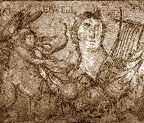 "The Yale University Art Gallery has acquired and will display five fragments of a Roman floor mosaic from Gerasa (now Jerash), a site in present-day Jordan that Yale excavated in association with the British in the 1920s and '30s. A fat garlanded boy sitting astride a panther, a partially nude maenad and two conversing satyrs are all part of the tableau of one of the five pieces of Roman mosaic recently acquired by the University art gallery."
"The Yale University Art Gallery has acquired and will display five fragments of a Roman floor mosaic from Gerasa (now Jerash), a site in present-day Jordan that Yale excavated in association with the British in the 1920s and '30s. A fat garlanded boy sitting astride a panther, a partially nude maenad and two conversing satyrs are all part of the tableau of one of the five pieces of Roman mosaic recently acquired by the University art gallery."
Penal Tattooing in Late Antiquity
 By Mark Gustafson
By Mark Gustafson
Calvin College
"The origins of tattooing are very ancient, and the modern fascination with the practice serves to remind us that it has been an enduring fixture in human history. Its functions are many and often overlap, but the particular focus here is on the tattoo as an aspect of punishment. Comparative evidence, however, is welcomed whenever it proves useful. This article first marshals and examines the late antique literary evidence (which is predominantly Christian) extending from North Africa in the third century to Constantinople in the ninth. Then that evidence is put in its legal context.
From at least the time of Augustus, the penal tattoo, which was generally placed on the face or forehead, had been associated with degradation. Such remained the case in late antiquity, and it also becomes clear that the tattoo accompanied a sentence of exile and hard labor, usually in mines or quarries. The deeper meaning of the tattoo and its placement on the forehead is considered in the light of modern understandings. There follows a discussion of the actual form taken by the tattoo, which normally displayed the name of the crime, the name of the emperor, or the name of the punishment. Based on the available data, the last option appears to have been the most common penal tattoo in this period.
Finally, the article hypothesizes that the Christians effected a transformation of the tattoo and subverted its original intent, so that, rather than being a sign of punishment, it became a sign of glory in which one could take pride. Thus the penal function, in some settings at least, was overtaken by a primarily religious one. "
Roman Wall Painting
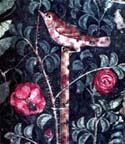 By M. Hoover, San Antonio College
By M. Hoover, San Antonio College
"Roman wall painting is described as having four distinct styles, identified from the wall paintings found at Pompeii, Herculaneum, Boscoreal and other cities buried under the volcanic ash of Mt. Vesuvius. Roman mosaics either imitated the painting styles or became very abstract.
The First Style Roman wall painting, called 'Incrustation style' is thought to imitate Greek painting that created flat areas of color and 'faux' finishes (like a fake marble or oak finish). In the second style Roman wall painting, called the "architectural style," space extends beyond the room with various perspective ("illusion of three-dimensional space on a flat two-dimensional surface) devices. Roman artists came close to developing a true linear perspective.
In the Third Style Roman Wall Painting, called the "Ornate Style," pictorial illusion is confined to "framed" images, where even the "framing" is painted on. The overall appearance is flat rather than a 3-d illusion of space. The Fourth Style Roman Wall Painting, called the "Intricate Style," confines full three-dimensional illusion to the "framed images," which are placed like pictures in an exhibition. The images themselves do not relate to one another nor do they present a narrative, as in the Second Style. The Fourth Style is also characterized by the open vistas and the use of aerial perspective, as well as the elaborate architectural framing.
Subscribe to:
Comments (Atom)